Search Result
Results for "
P-glycoprotein
" in MedChemExpress (MCE) Product Catalog:
1
Biochemical Assay Reagents
13
Isotope-Labeled Compounds
| Cat. No. |
Product Name |
Target |
Research Areas |
Chemical Structure |
-
- HY-15134
-
|
OC 144-093; OC 144093
|
P-glycoprotein
|
Cancer
|
|
ONT-093 is a potent inhibitor of P-glycoprotein pump. ONT-093 has the potential for the research cancer diseases .
|
-

-
- HY-A0279A
-
|
Mikamycin B; Mikamycin IA
|
Bacterial
Antibiotic
|
Infection
|
|
Pristinamycin IA (Mikamycin B) is a cycle-peptidic macrolactone antibiotic. Pristinamycin IA is a substrate of P-glycoprotein and inhibits its function. Pristinamycin IA is active against StaphyloEoccus and Srreptococcus .
|
-
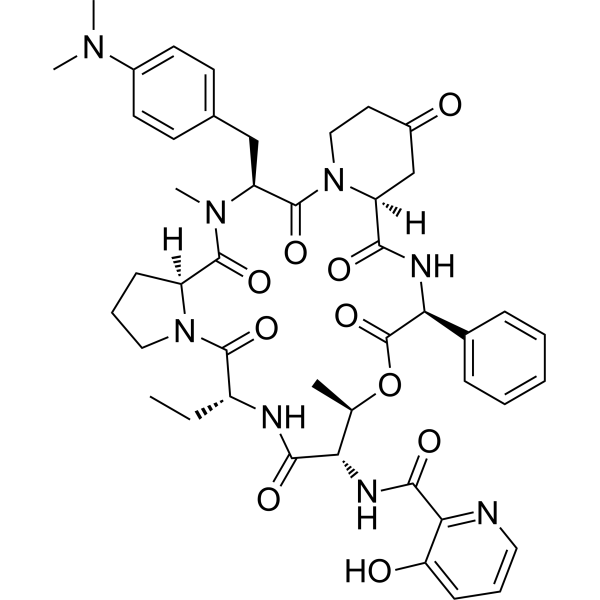
-
- HY-50879
-
|
GF120918; GW0918; GG918; GW120918
|
P-glycoprotein
BCRP
|
Cancer
|
|
Elacridar is an orally active P-glycoprotein (Pgp) and breast cancer resistance protein (BCRP) inhibitor. Elacridar can be used to examine the influence of efflux transporters on agent distribution to brain and the research of cancer .
|
-

-
- HY-157330
-
|
|
P-glycoprotein
Apoptosis
|
Cancer
|
|
P-gp inhibitor 16 (compound 14) is a p-glycoprotein inhibitor. P-gp inhibitor 16 significantly increases Doxorubicin-induced apoptosis and shows anticancer effects .
|
-
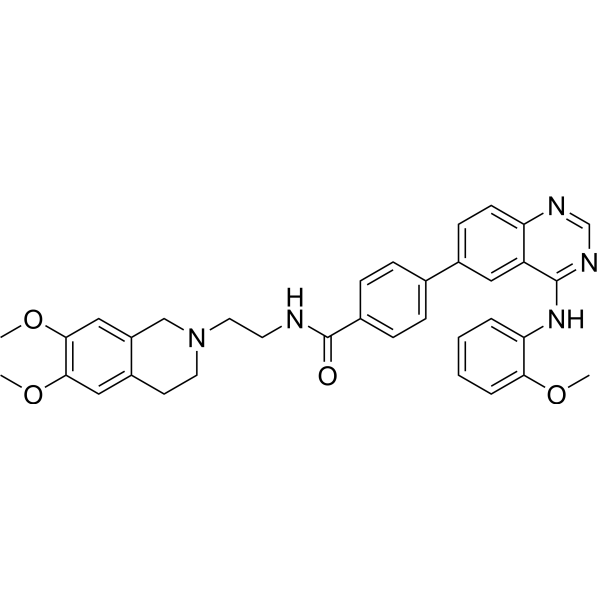
-
- HY-128038
-
|
|
Opioid Receptor
|
Neurological Disease
|
|
N-Desmethyl-loperamide is a major metabolite of loperamide, a drug that selectively activates peripheral μopioid receptors with a Ki value of 0.16 nM. N-Desmethyl-loperamide is a substrate of the ATP-dependent efflux transporter P-glycoprotein .
|
-
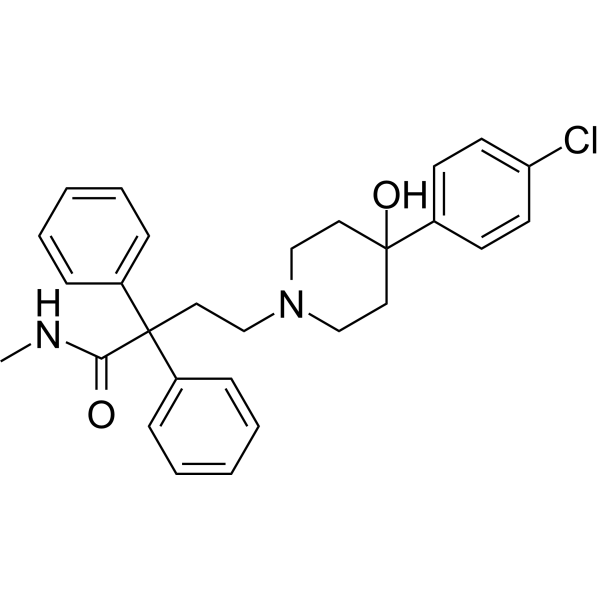
-
- HY-119823
-
|
|
P-glycoprotein
|
Cancer
|
|
PGP-4008 is a specific P-glycoprotein (Pgp) inhibitor. PGP-4008 inhibits tumor growth in a murine syngeneic Pgp-mediated multiple agent resistance (MDR) solid tumor model when given in combination with Doxorubicin .
|
-
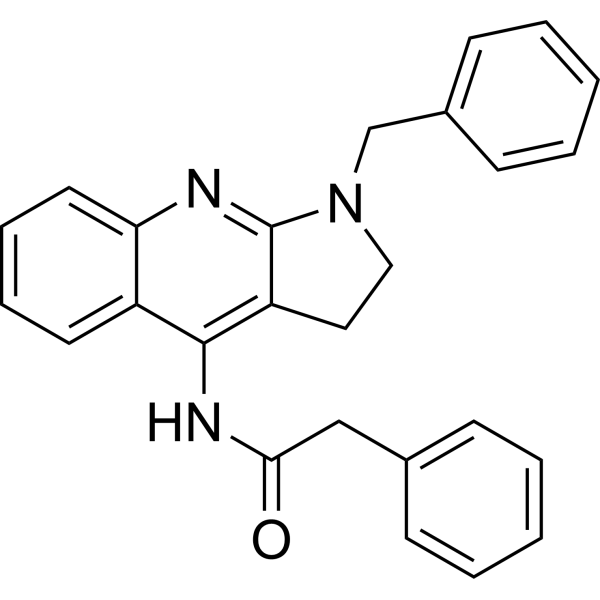
-
- HY-50880
-
|
GF120918A
|
P-glycoprotein
BCRP
|
Cancer
|
|
Elacridar hydrochloride (GF120918A) is an orally active P-glycoprotein (P-gp) and breast cancer resistance protein (BCRP) inhibitor. Elacridar hydrochloride can be used to examine the influence of efflux transporters on agent distribution to brain and it can be used for the research of cancer .
|
-
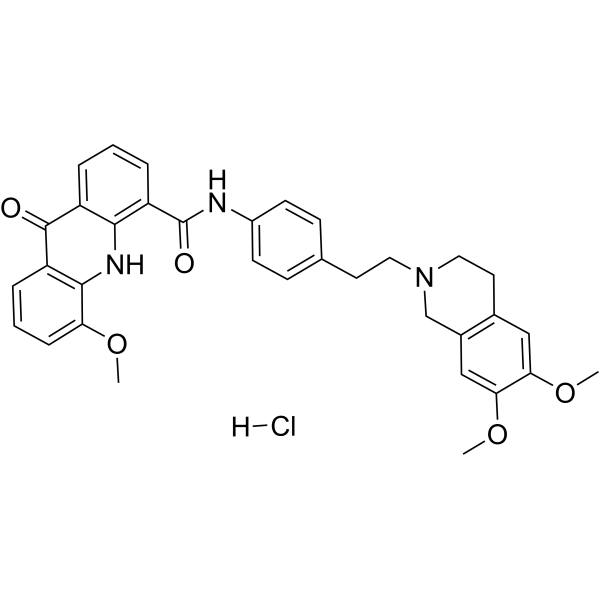
-
- HY-146096
-
|
|
P-glycoprotein
Apoptosis
|
Cancer
|
|
RMS3, a tetrandrine analogue, is a potent P-glycoprotein (P-gp) inhibitor. RMS3 has markedly antiproliferative and cytotoxic effects on cancer cells. RMS3 causes PARP cleavage, a marker for cells undergoing apoptosis. RMS3 has strong anticancer property .
|
-
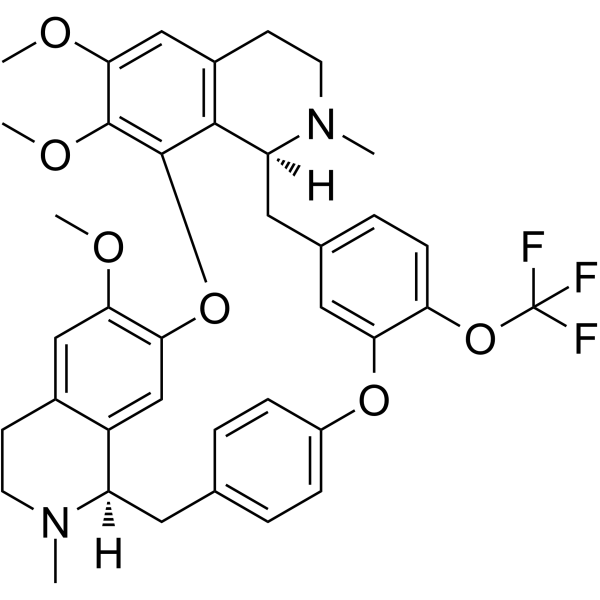
-
- HY-N3085
-
|
|
P-glycoprotein
Apoptosis
|
Metabolic Disease
Cancer
|
|
Phellamurin is a plant flavonone glycoside from the leaves of Phellodendron amurense and inhibits intestinal P-glycoprotein. Phellamurin also inhibits egg laying by Papilio protenor. Phellamurin induces cells apoptosis and has anti-tumor activity .
|
-
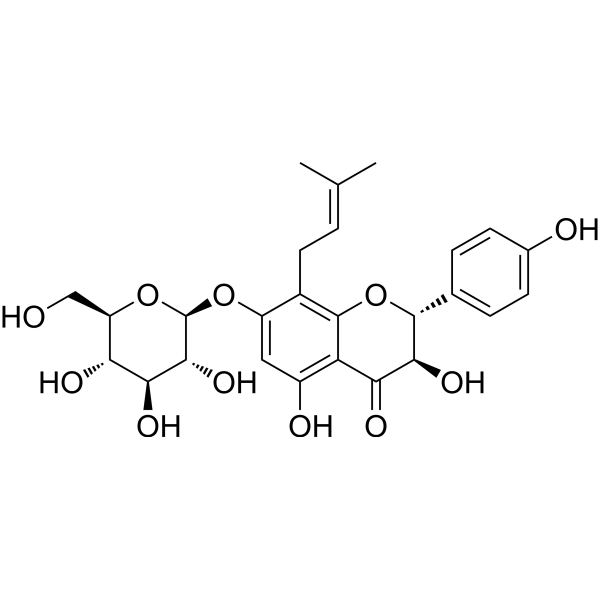
-
- HY-U00247
-
-
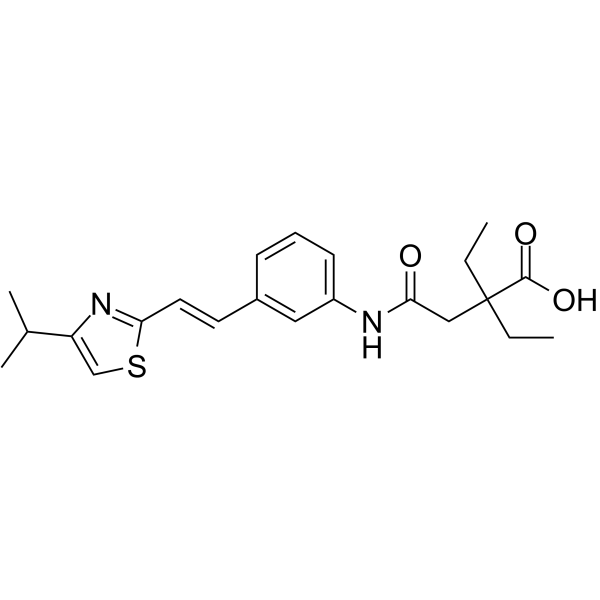
-
- HY-U00244A
-
|
P2647 hydrochloride; BZQ hydrochloride; Benzoquinamide hydrochloride
|
Adrenergic Receptor
|
Cancer
|
|
Benzquinamide (P2647) is an antiemetic which can bind to the α2A, α2B, and α2C adrenergic receptors (α2-AR) with Ki values of 1,365, 691, and 545 nM, respectively. Benzquinamide also inhibits P-glycoprotein mediated drug efflux and potentiates anticancer agent cytotoxicity in multidrug resistant cells .
|
-

-
- HY-19626
-
-
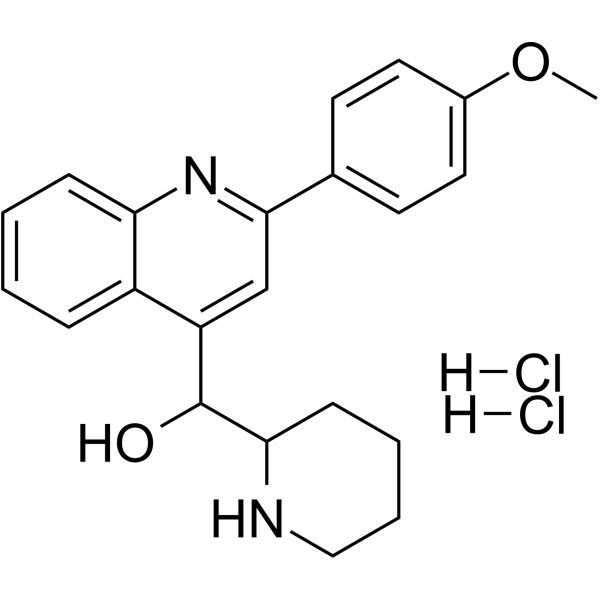
-
- HY-13646
-
-
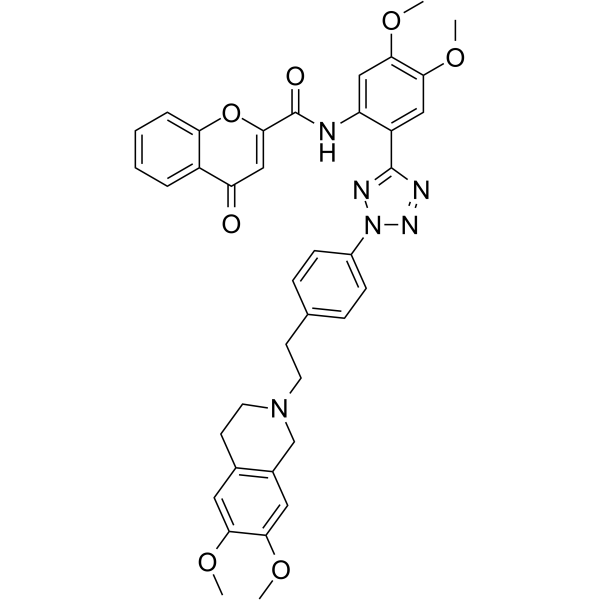
-
- HY-13646A
-
|
HM30181 mesylate; HM30181A mesylate
|
P-glycoprotein
|
Cancer
|
|
Encequidar mesylate (HM30181 mesylate; HM30181A mesylate) is a competitive and potent P-glycoprotein inhibitor.
|
-
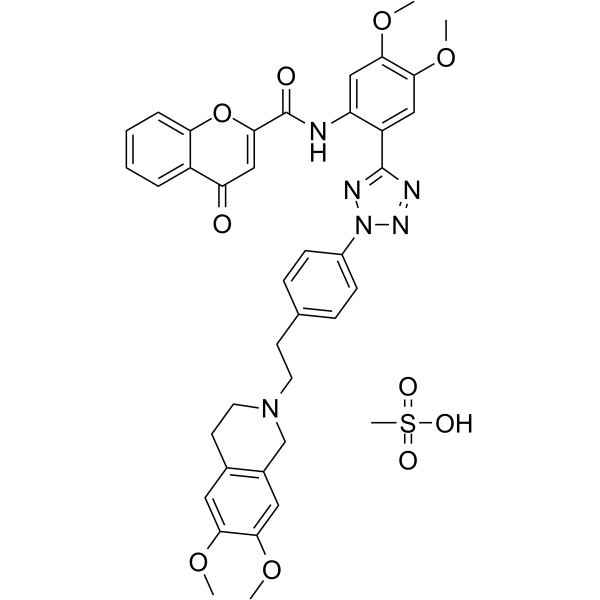
-
- HY-107212
-
|
|
Parasite
Chloride Channel
P-glycoprotein
Bacterial
|
Infection
|
|
Selamectin, a semi-synthetic macrocyclic lactone, is a potent parasiticide and anthelminthic. Selamectin activates glutamate-gated chloride channels in neurons and pharyngeal muscles to prevent heartworm, Lymphatic filariae, and nematode infection. Selamectin is also a potent P-glycoprotein substrate and a P-glycoprotein inhibitor with an IC50 of 120 nM .
|
-

-
- HY-143792
-
|
|
P-glycoprotein
|
Neurological Disease
|
|
HTT-D3 is a potent and orally active huntingtin (HTT) splicing modulator. HTT-D3 acts by promoting the inclusion of a pseudoexon containing a premature termination codon (stop-codon psiExon), leading to HTT mRNA degradation and reduction of HTT levels. HTT-D3 reduces p-glycoprotein (P-gp) efflux, and can be uesd for Huntington's disease research .
|
-
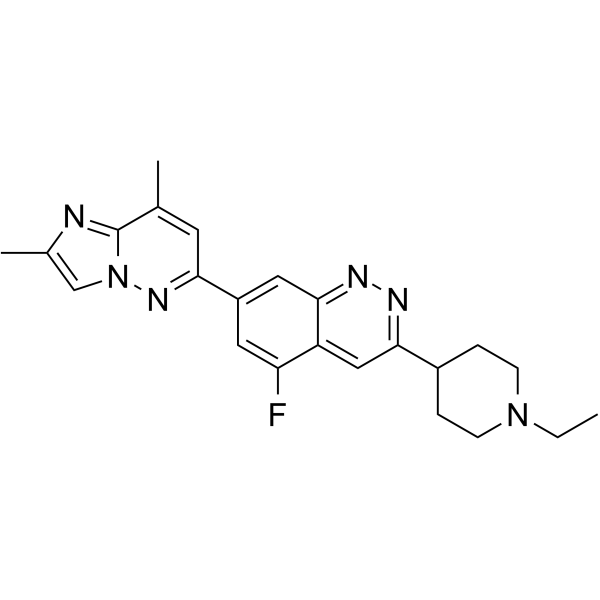
-
- HY-19642A
-
|
MGCD265 hydrochloride
|
TAM Receptor
c-Met/HGFR
|
Cancer
|
|
Glesatinib hydrochloride (MGCD265 hydrochloride) is an orally active, potent MET/SMO dual inhibitor. Glesatinib hydrochloride, a tyrosine kinase inhibitor, antagonizes P-glycoprotein (P-gp) mediated multidrug resistance (MDR) in non-small cell lung cancer (NSCLC) .
|
-
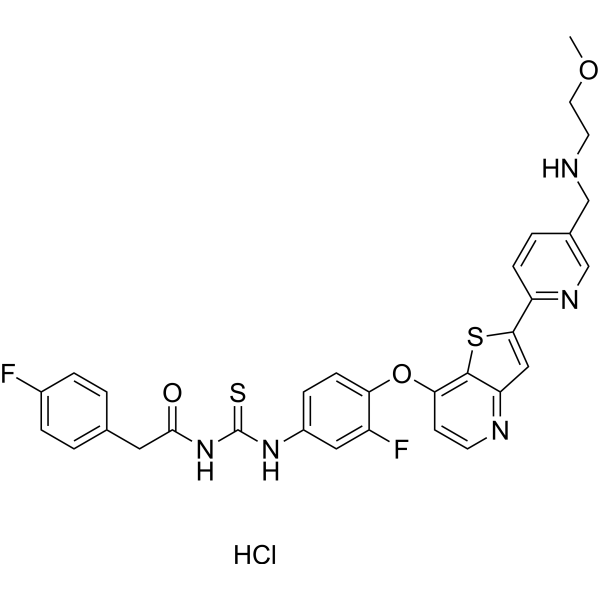
-
- HY-19642
-
|
MGCD265
|
TAM Receptor
c-Met/HGFR
|
Cancer
|
|
Glesatinib (MGCD265) is an orally active, potent MET/SMO dual inhibitor. Glesatinib, a tyrosine kinase inhibitor, antagonizes P-glycoprotein (P-gp) mediated multidrug resistance (MDR) in non-small cell lung cancer (NSCLC) .
|
-
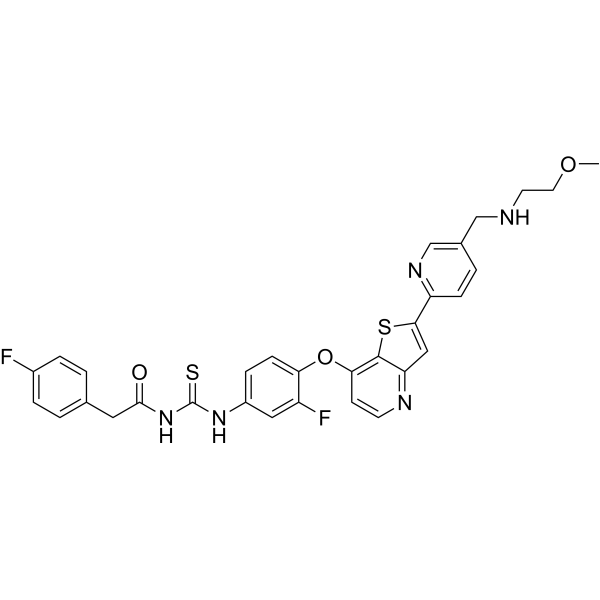
-
- HY-149277
-
|
|
P-glycoprotein
|
Cancer
|
|
FM04 is a potent P-glycoprotein (P-gp) inhibitor (EC50=83 nM). FM04 inhibits P-gp in 2 mechanism: (1)FM04 binds to Q1193, followed by interacting with the functionally critical residues H1195 and T1226; or (2)FM04 binds to I1115 (a functionally critical residue itself), disrupting the R262-Q1081-Q1118 interaction pocket and uncoupling ICL2-NBD2 interaction and thereby inhibiting P-gp .
|
-
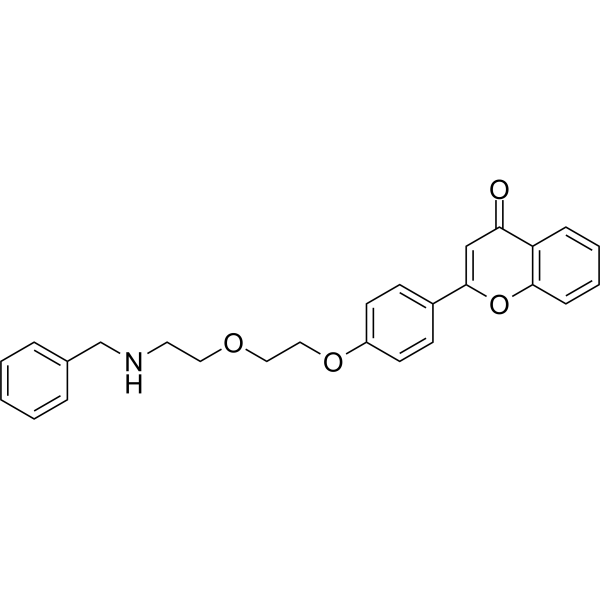
-
- HY-17384
-
|
PSC 833
|
P-glycoprotein
|
Cancer
|
|
Valspodar (PSC 833) is a selective P-glycoprotein inhibitor that has been used as an experimental cancer treatment and chemosensitizer.
|
-
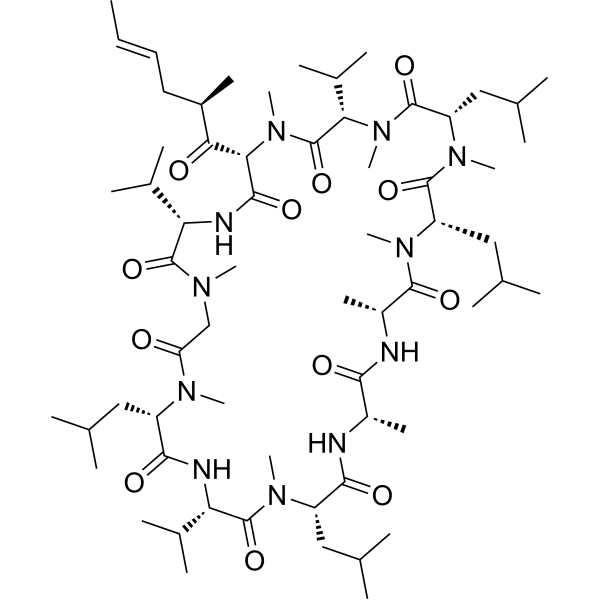
-
- HY-10550A
-
|
XR9576 methanesulfonate, hydrate
|
P-glycoprotein
|
Cancer
|
|
Tariquidar methanesulfonate, hydrate (XR9576 methanesulfonate, hydrate) is a potent and specific inhibitor of P-glycoprotein (P-gp) with a Kd of 5.1 nM.
|
-
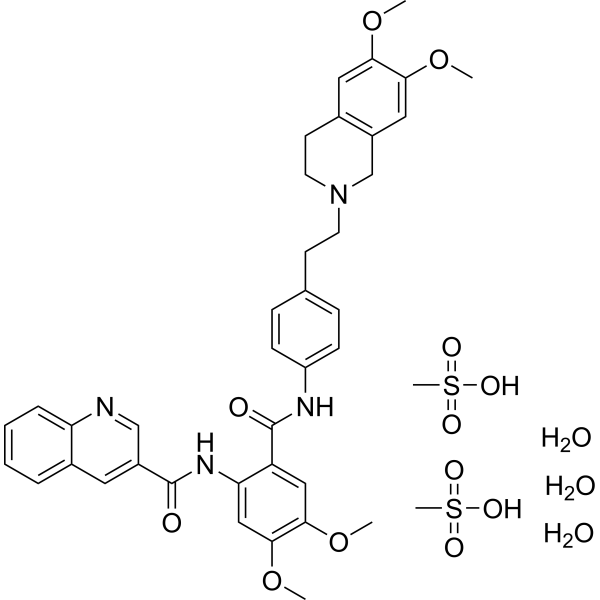
-
- HY-144366
-
|
|
P-glycoprotein
|
Cancer
|
|
P-gp inhibitor 3 is an effective P-glycoprotein (P-gp) inhibitor. P-gp inhibitor 3 inhibits the efflux function of P-gp by activating P-gp ATPase. P-gp inhibitor 3 has relatively stronger multidrug resistance (MDR) reversal ability and enhances the anti-tumor activity of Paclitaxel .
|
-
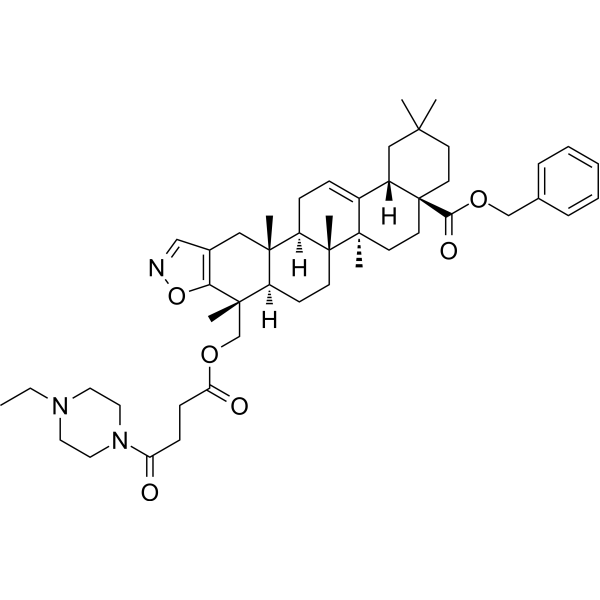
-
- HY-N0692
-
|
Gomisin-A; TJN-101; Wuweizi alcohol-B
|
Reactive Oxygen Species
Cytochrome P450
Autophagy
|
Cancer
|
|
Schisandrol B (Gomisin-A) is a major active constituent of Schisandra chinensis with hepato-protective effects. Schisandrol B inhibits reactive oxygen species (ROS) production. Schisandrol B inhibits the activity of P-glycoprotein and CYP3A and also has anti-inflammatory, anti-diabetic and antioxidant activities .
|
-
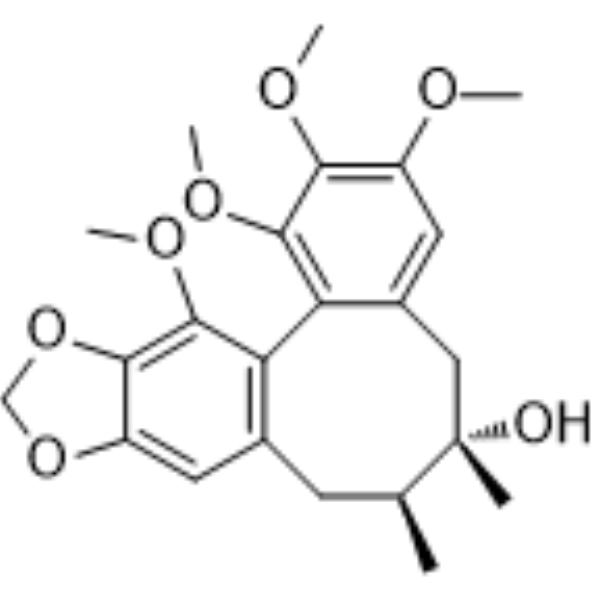
-
- HY-146117
-
|
|
P-glycoprotein
|
Cancer
|
|
P-gp modulator 2 (Compound 27) is a potent, competitive, allosteric P-glycoprotein (P-gp) modulator .
|
-
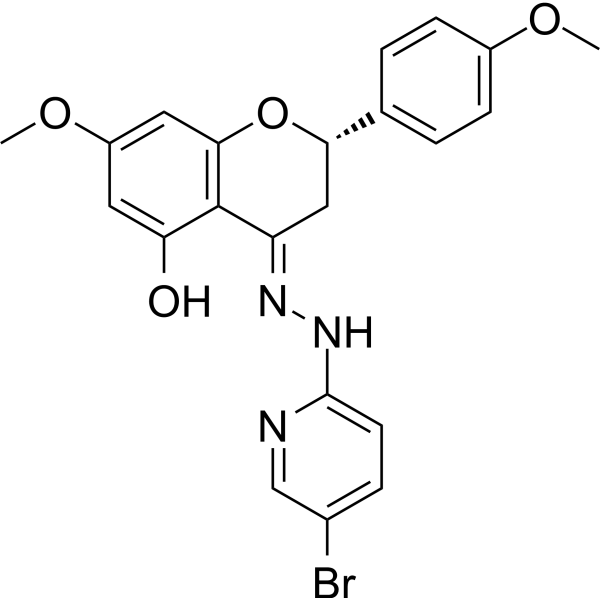
-
- HY-146118
-
|
|
P-glycoprotein
|
Cancer
|
|
P-gp modulator 3 (Compound 37) is a potent, competitive, allosteric P-glycoprotein (P-gp) modulator .
|
-
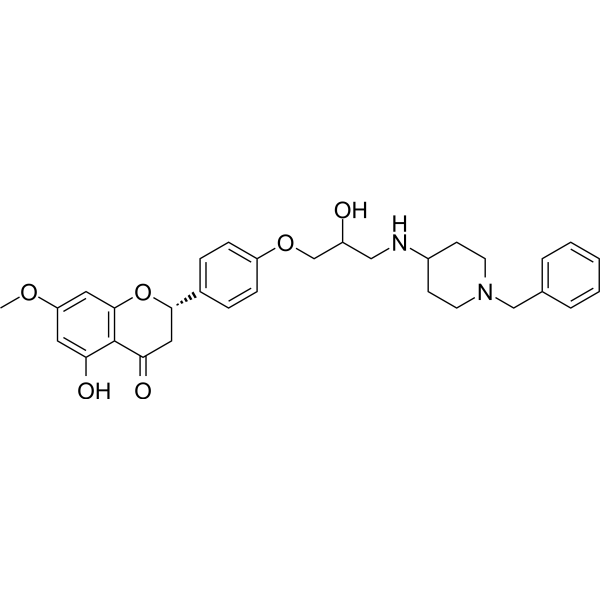
-
- HY-107212R
-
|
|
Parasite
Chloride Channel
P-glycoprotein
Bacterial
|
Infection
|
|
Selamectin (Standard) is the analytical standard of Selamectin. This product is intended for research and analytical applications. Selamectin, a semi-synthetic macrocyclic lactone, is a potent parasiticide and anthelminthic. Selamectin activates glutamate-gated chloride channels in neurons and pharyngeal muscles to prevent heartworm, Lymphatic filariae, and nematode infection. Selamectin is also a potent P-glycoprotein substrate and a P-glycoprotein inhibitor with an IC50 of 120 nM .
|
-
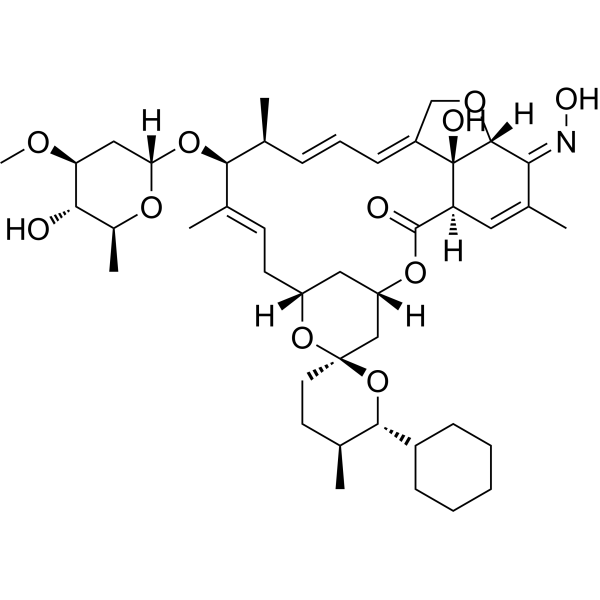
-
- HY-125486
-
|
|
P-glycoprotein
|
Cancer
|
|
Reversin 121 is a P-glycoprotein inhibitor. Reversin 121 increases the ATPase activity of MDR1. Reversin 121 reverses P-glycoprotein-mediated multidrug resistance. Reversin 121 can be used in the research of cancers .
|
-
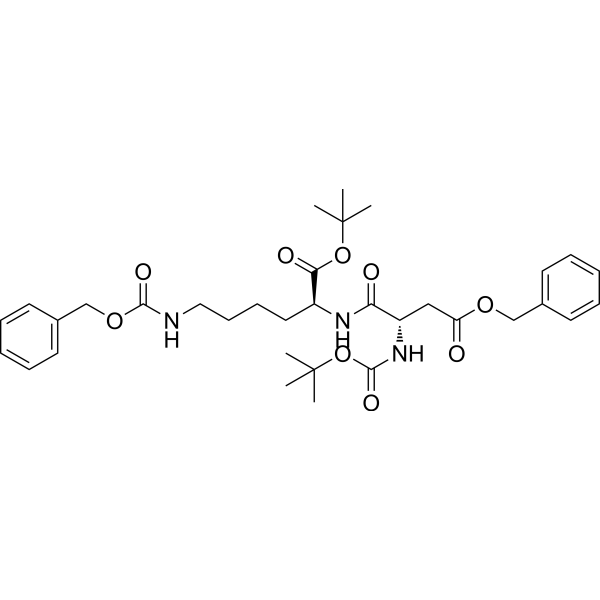
-
- HY-17013
-
|
|
P-glycoprotein
|
Cancer
|
|
Dofequidar(MS-209) is a novel quinoline compound, which can reverse P-glycoprotein (P-gp)-mediated MDR.
|
-
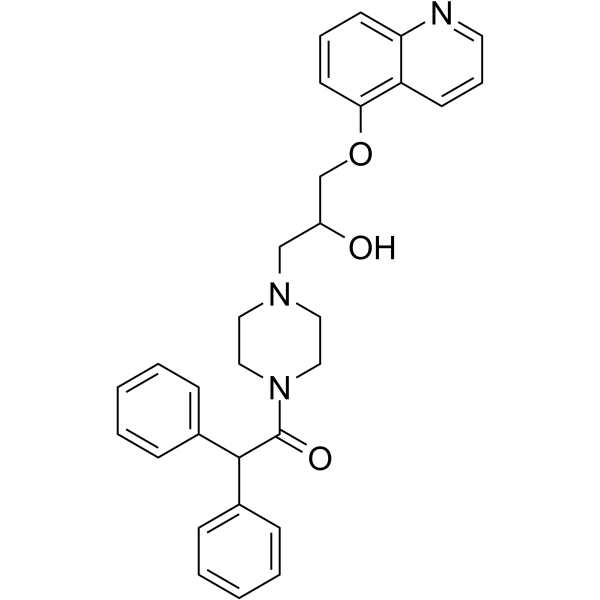
-
- HY-146097
-
|
|
P-glycoprotein
Apoptosis
|
Cancer
|
|
RMS5, a tetrandrine analogue, is a potent P-glycoprotein (P-gp) inhibitor. RMS5 has markedly antiproliferative and cytotoxic effects on cancer cells. RMS5 slightly diminishes the expression of the anti-apoptotic Bcl-2 family proteins Bcl-XL and Mcl-1. RMS3 causes PARP cleavage, a marker for cells undergoing apoptosis. RMS5 has strong anticancer property .
|
-
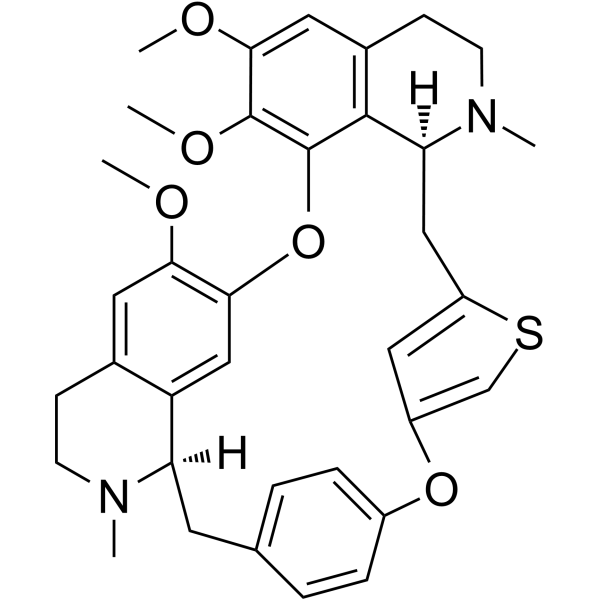
-
- HY-10550
-
Tariquidar
Maximum Cited Publications
46 Publications Verification
XR9576
|
P-glycoprotein
|
Cancer
|
|
Tariquidar (XR9576) is a potent and specific inhibitor of P-glycoprotein (P-gp) with the high affinity (Kd=5.1 nM) .
|
-

-
- HY-13574A
-
|
VX-710
|
P-glycoprotein
|
Cancer
|
|
Biricodar (VX-710) is a modulator of P-glycoprotein and MRP-1; shows effective chemosensitizing activity in multidrug resistant cells.
|
-

-
- HY-110377
-
|
XR9576 dihydrochloride
|
P-glycoprotein
|
Cancer
|
|
Tariquidar dihydrochloride (XR9576 dihydrochloride) is a potent and specific inhibitor of P-glycoprotein (P-gp) with the high affinity (Kd=5.1 nM) .
|
-
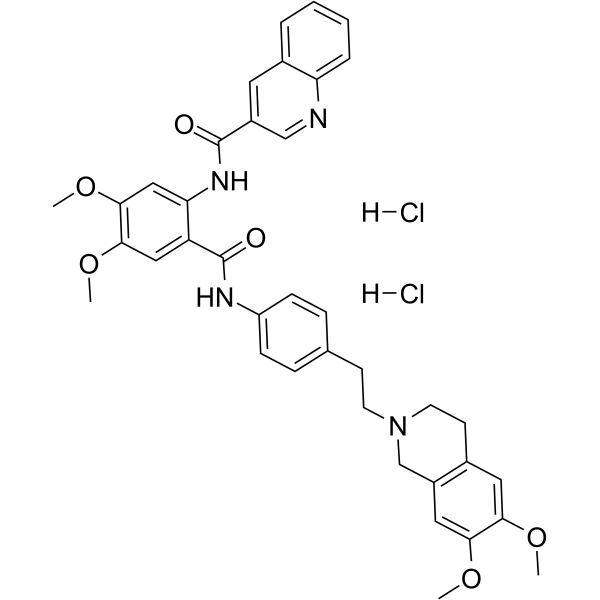
-
- HY-W009141
-
|
Glyceryl palmitate
|
P-glycoprotein
|
Cancer
|
|
1-Monopalmitin, a bitter melon extract, inhibits the P-glycoprotein (P-gp) activity in intestinal Caco-2 cells .
|
-

-
- HY-100750
-
-

-
- HY-135328
-
-
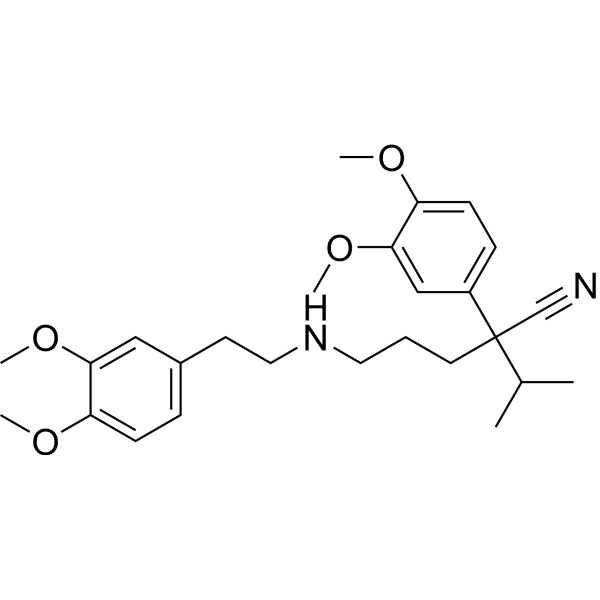
-
- HY-112912
-
|
|
P-glycoprotein
|
Cancer
|
|
P-gp modulator 1 is a high affinity, orally available modulator of P-glycoprotein (Pgp), can reverse the Pgp-mediated multidrug resistance ((MDR) .
|
-
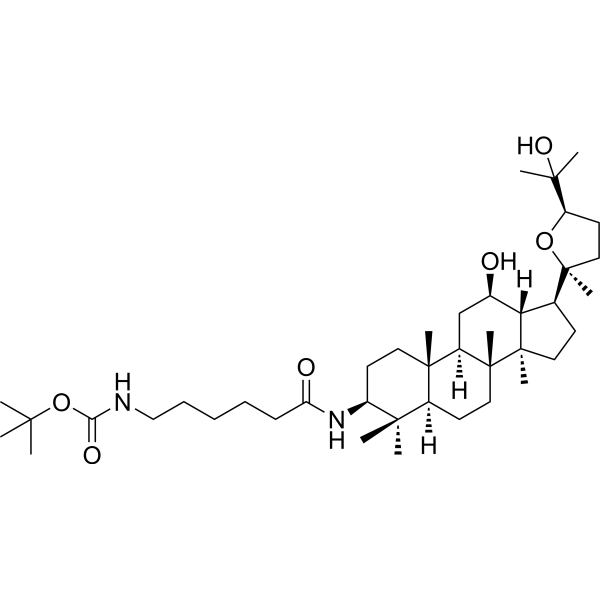
-
- HY-107643
-
|
CBLC4H10
|
P-glycoprotein
|
Cancer
|
|
Reversan (CBLC4H10) is a potent and nontoxic multidrug resistance-associated protein 1 (MRP1) and P-glycoprotein (Pgp) inhibitor .
|
-
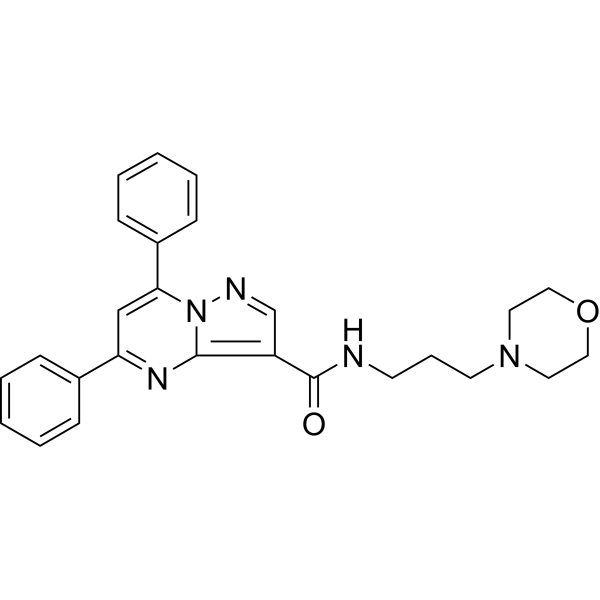
-
- HY-136934
-
|
[Boc-Glu(Obzl)]2-Lys-Ome
|
P-glycoprotein
|
Cancer
|
|
Reversin 205 ([Boc-Glu(Obzl)]2-Lys-Ome) is a P-glycoprotein (ABCB1) inhibitor. Reversin 205 is a peptide chemosensitizer .
|
-
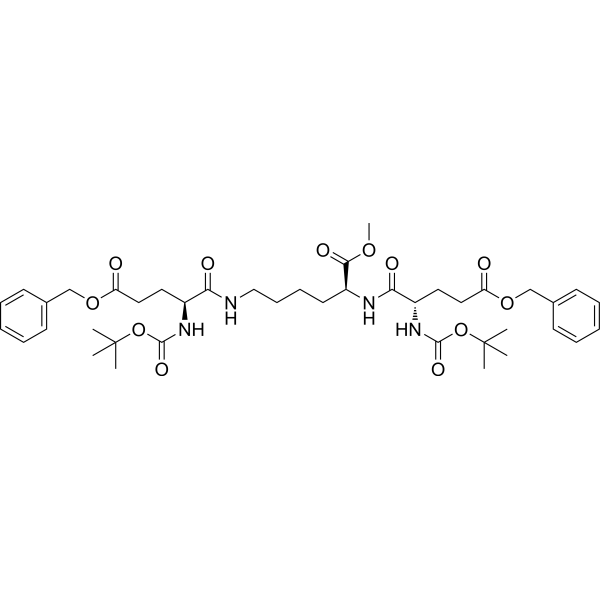
-
- HY-155152
-
|
|
P-glycoprotein
BCRP
|
Cancer
|
|
P-gp/BCRP-IN-2 (compound 15) is an oxadiazole derivative and a dual inhibitor of the ABC transporter P-glycoprotein (IC50: 1.6 nM) and BCRP (IC50: 600 nM). P-gp/BCRP-IN-2 also enhances the anti-proliferative effects of Doxorubicin (HY-15142A) in drug-resistant human adenocarcinoma colon cancer cell lines HT29/DX and MDCK-MDR1 cells .
|
-
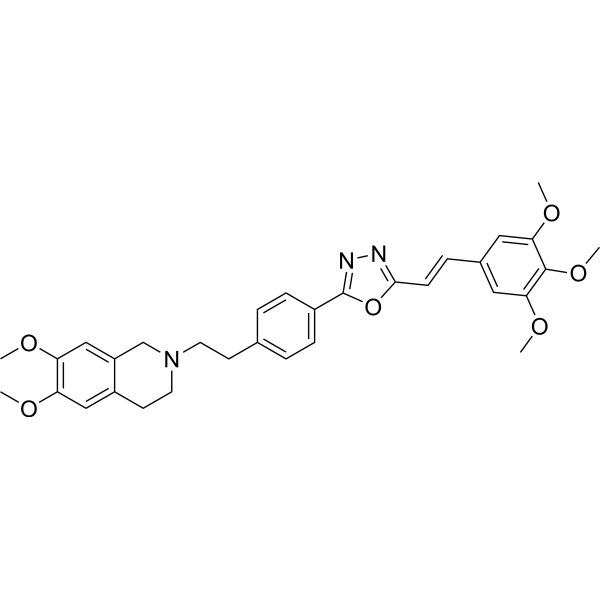
-
- HY-121793
-
|
(-)-Roemerine
|
P-glycoprotein
Endogenous Metabolite
|
Cancer
|
|
Roemerine, an aporphine alkaloid, isolated from the leaves of Fibraurea recisa Pierre, functions by interacting with P-glycoprotein. Roemerine reverses the multidrug-resistance phenotype with cultured cells .
|
-
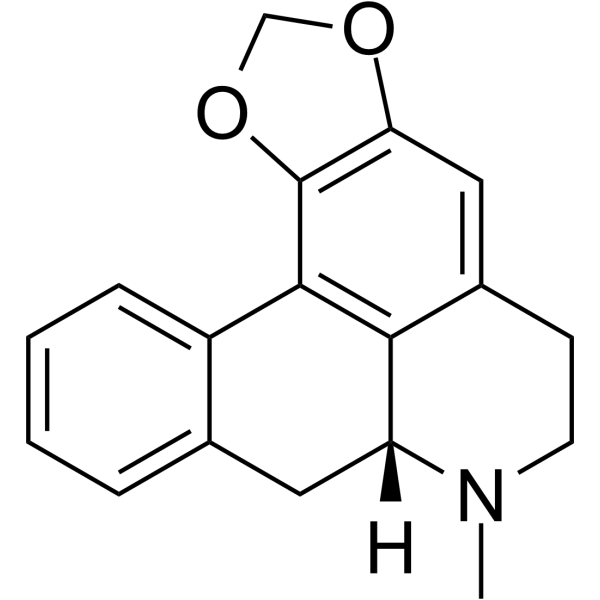
-
- HY-W001601
-
|
|
iGluR
|
Neurological Disease
|
|
Budipine is an anti-parkinson agent. Budipine also is a substrate of P-glycoprotein (P-gp), is mediated the uptake into the brain by P-gp. Budipine also is N-methyl-d-aspartate (NMDA) antagonist, and has indirect dopaminergic effects through an improved dopamine release, the inhibition of monoamine oxidase type B (MAO-B). Budipine can be used for the research of CNS disorders include Parkinson disease .
|
-
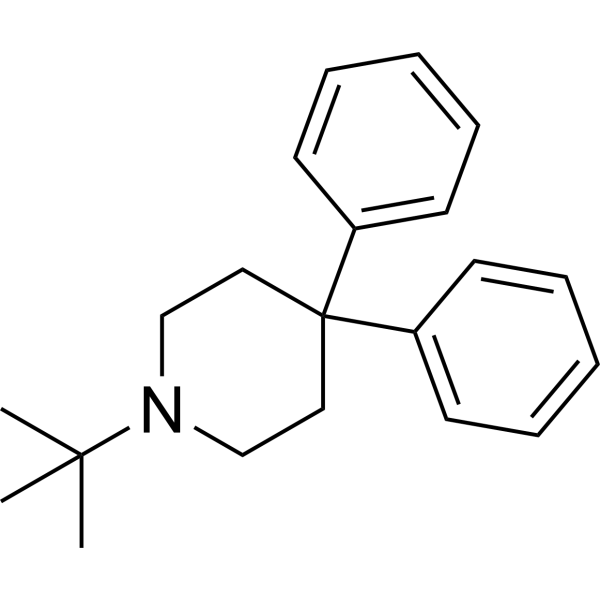
-
- HY-N0425
-
|
|
P-glycoprotein
|
Cancer
|
|
Epoxylathyrol, an epoxylathyrane derivative isolated from the Euphorbia boetica, is a P-glycoprotein (P-gp) inhibitor. Epoxylathyrol is a P-gp-mediated multidrug resistance (MDR) reverser .
|
-
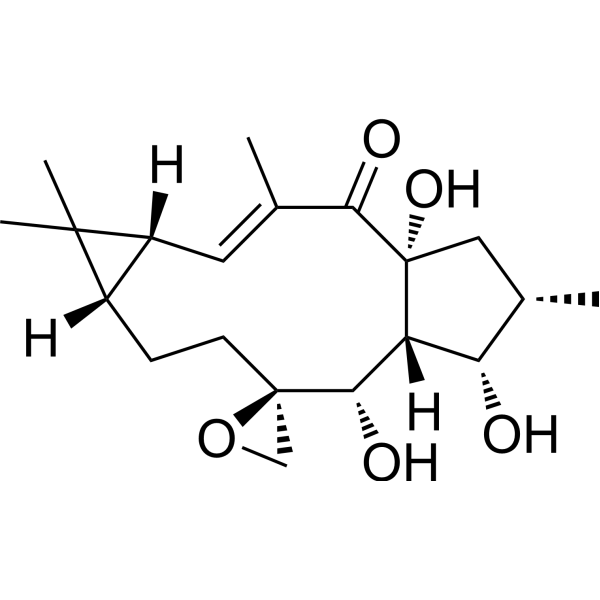
-
- HY-N0144
-
-
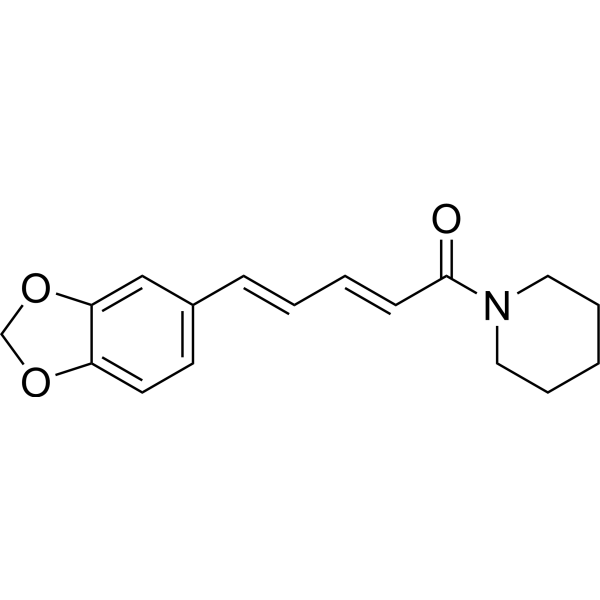
-
- HY-N1941
-
|
|
|
|
|
Isosinensetin, a polymethoxylated flavone extracted from pericarpium citri reticulatae viride, exhibits inhibition on P-glycoprotein (P-gp) in MDR1-MDCKII cells .
|
-
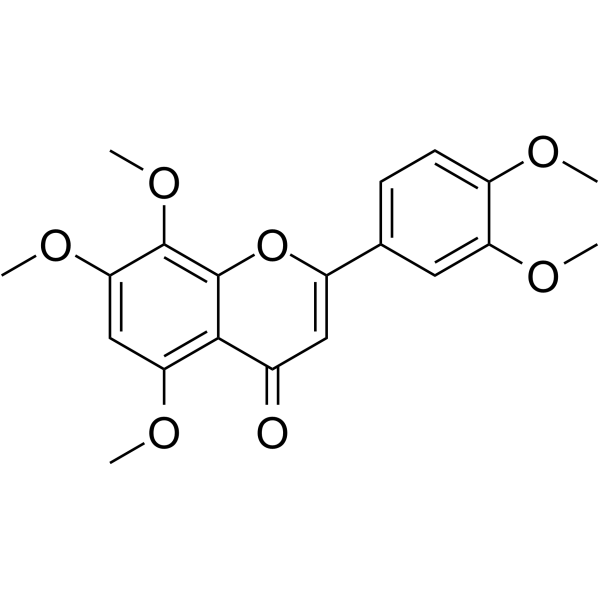
-
- HY-132866
-
|
|
P-glycoprotein
|
Cancer
|
|
YS-370 (compound 44) is a potent, high selective, and orally active inhibitor of P-glycoprotein (P-gp). YS-370 stimulates the P-gp ATPase activity and has moderate inhibition against CYP3A4. YS-370 effectively reverses multidrug resistance (MDR) to paclitaxel and colchicine in SW620/AD300 and HEK293T-ABCB1 cells. YS-370 in combination with paclitaxel achieves much stronger antitumor activity .
|
-
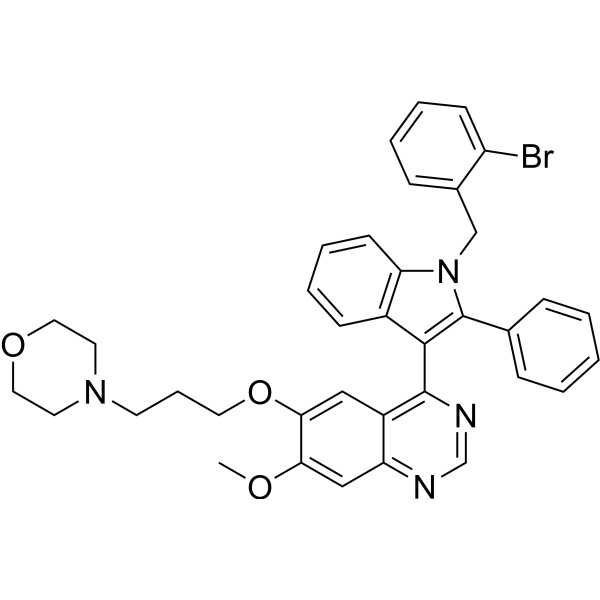
-
- HY-N2103
-
|
|
P-glycoprotein
|
Cancer
|
|
Tenacissoside G is a C21 steroid from the stems of Marsdenia tenacissima. Tenacissoside G reverses multidrug resistance in P-glycoprotein (Pgp)-overexpressing multidrug-resistant cancer cells .
|
-
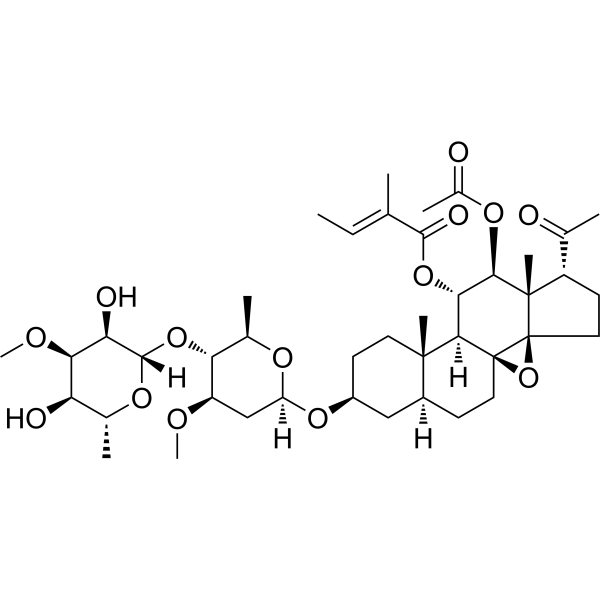
-
- HY-126906
-
|
|
Antibiotic
P-glycoprotein
|
Cancer
|
|
Milbemycin A4 inhibits P-glycoprotein activity, and reverses multidrug resistance of tumor cells. Milbemycins are a family of macrolide antibiotics with insecticidal and acaricidal activity sup>[2].
|
-
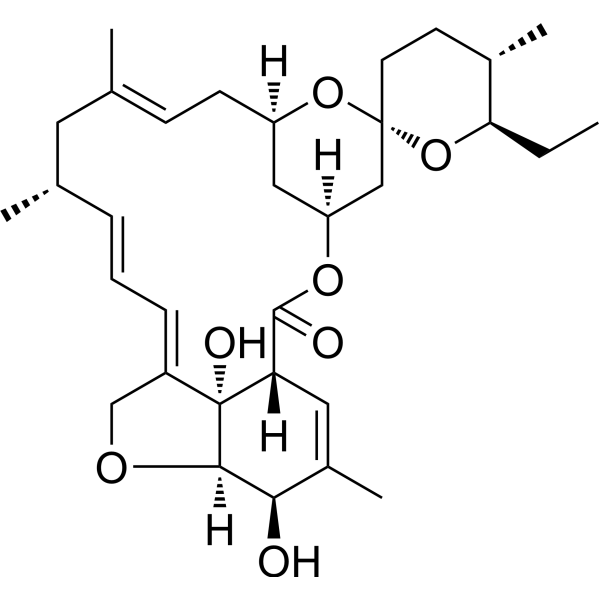
-
- HY-N6932
-
|
|
|
|
|
Voacamine, an indole alkaloid, exhibits potent cannabinoid CB1 receptor antagonistic activity . Voacamine also inhibits P-glycoprotein (P-gp) action in multidrug-resistant tumor cells .
|
-
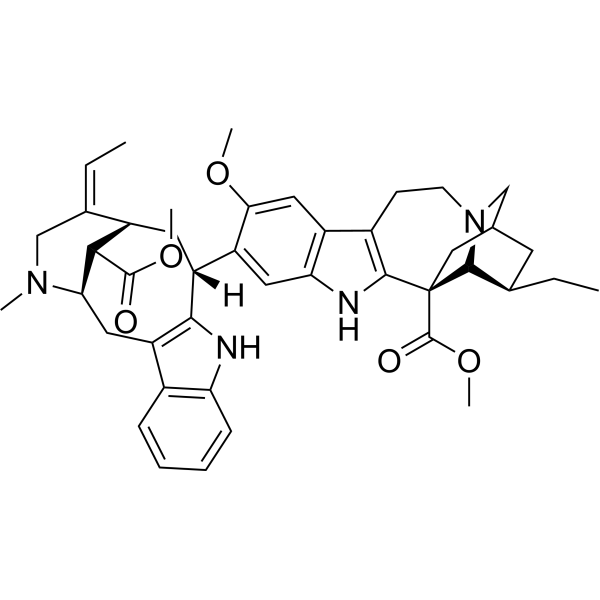
-
- HY-133948
-
|
Glyceryl palmitoleate
|
Biochemical Assay Reagents
|
Others
|
|
1-Palmitoleoyl glycerol is a biologically active monoacylglycerol. It increases daunomycin accumulation, shown to inhibit P-glycoprotein in Caco-2 cells. 1-Palmitoleoyl glycerol induces thymocyte apoptosis.
|
-
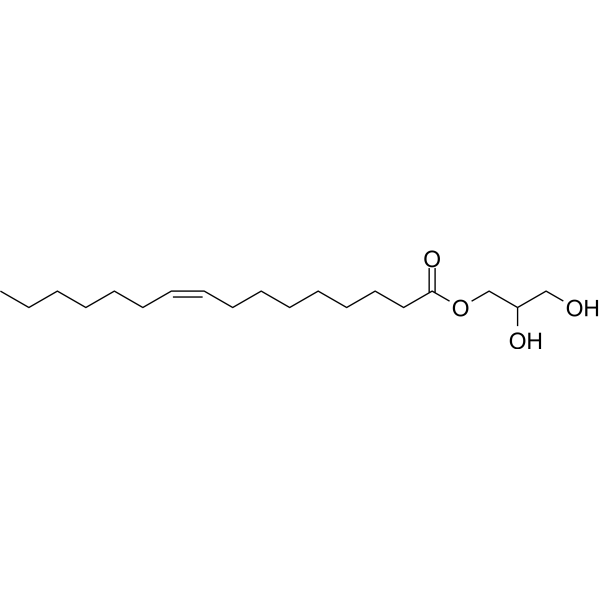
-
- HY-50671
-
|
RS 33295-198 trihydrochloride; LY-335979 trihydrochloride
|
P-glycoprotein
|
Cancer
|
|
Zosuquidar (LY335979) trihydrochloride is a P-glycoprotein (P-gp) inhibitor (Ki=59 nM). Zosuquidar trihydrochloride shows anti-tumor activities, and can be used in acute myelogenous leukemia (AML) research .
|
-
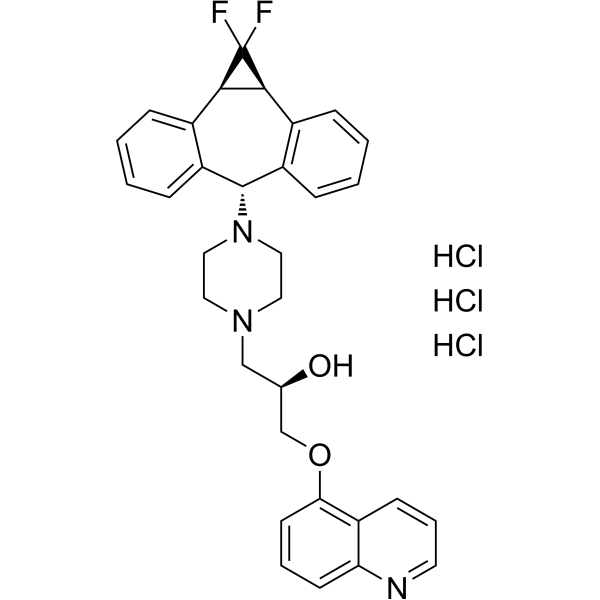
- HY-15255
-
|
RS 33295-198; LY-335979
|
P-glycoprotein
|
Cancer
|
|
Zosuquidar (LY335979) is a P-glycoprotein (P-gp) inhibitor (Ki=59 nM). Zosuquidar shows anti-tumor activities, and can be used in acute myelogenous leukemia (AML) research .
|
-
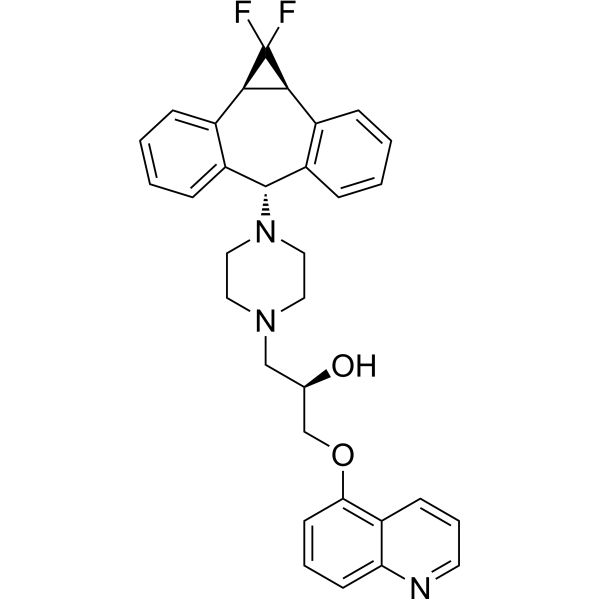
- HY-N1916
-
|
|
Glutathione S-transferase
P-glycoprotein
|
Cancer
|
|
Coniferyl ferulate, a strong inhibitor of glutathione S-transferase (GST), reverses multidrug resistance and downregulates P-glycoprotein. Coniferyl ferulate shows strong inhibition of human placental GST with an IC50 of 0.3 μM.
|
-
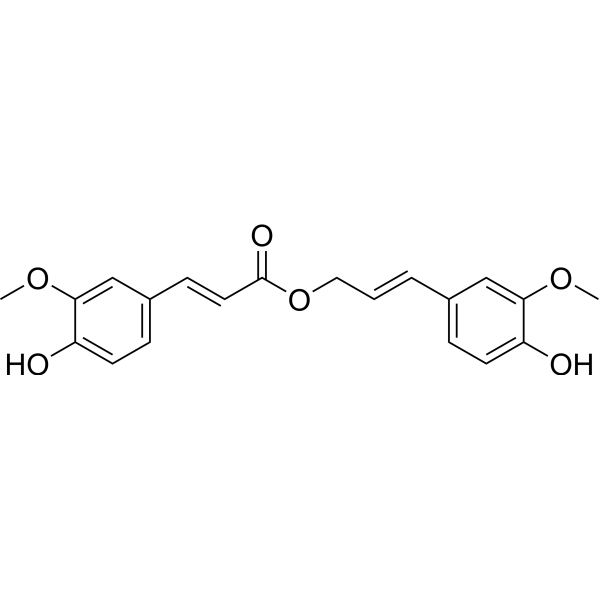
- HY-135336
-
|
(R)-(+)-Verapamil hydrochloride
|
P-glycoprotein
Apoptosis
|
Cancer
|
|
(R)-Verapamil hydrochloride ((R)-(+)-Verapamil hydrochloride) is a P-Glycoprotein inhibitor. (R)-Verapamil hydrochloride blocks MRP1 mediated transport, resulting in chemosensitization of MRP1-overexpressing cells to anticancer agents .
|
-
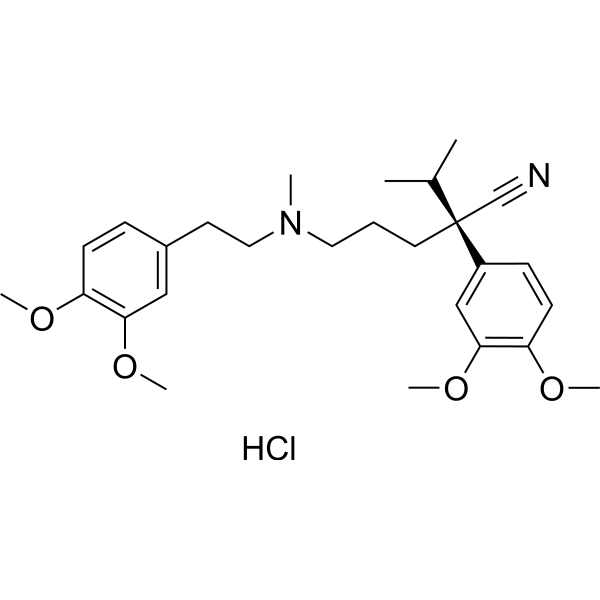
- HY-13646C
-
|
HM30181 mesylate hydrochloride; HM30181A mesylate hydrochloride
|
P-glycoprotein
|
Cancer
|
|
Encequidar (HM30181) mesylate hydrochloride is a potent and selective inhibitor of P-glycoprotein (MDR1). Encequidar mesylate hydrochloride improves anti-tumor efficacy of Paclitaxel (HY-B0015) in mouse tumor models .
|
-
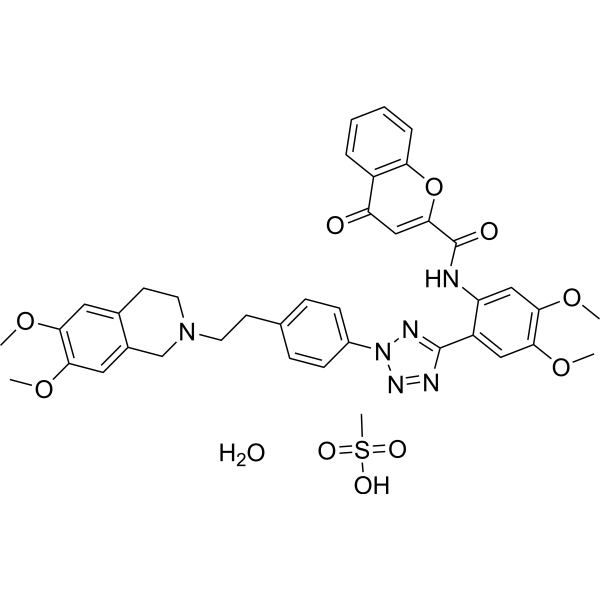
- HY-16191
-
|
|
Microtubule/Tubulin
Apoptosis
|
Cancer
|
|
ELR510444 is a novel microtubule disruptor; inhibits MDA-MB-231 cell proliferation with IC50 of 30.9 nM; not a substrate for the P-glycoprotein drug transporter and retains activity in βIII-tubulin-overexpressing cell lines.
|
-
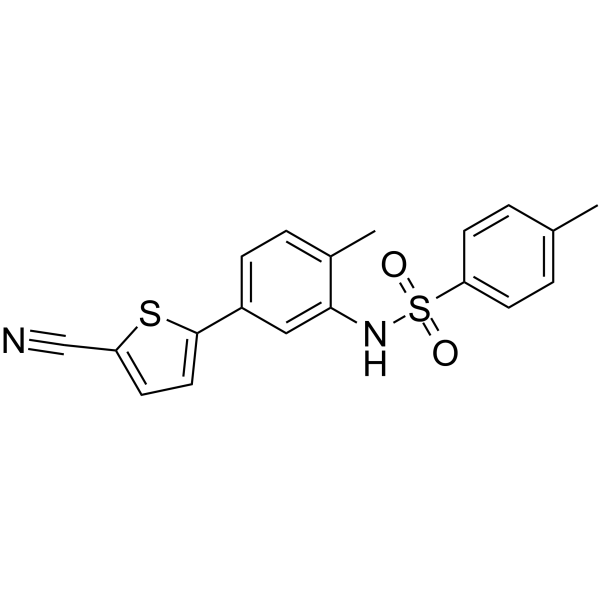
- HY-135328AS
-
|
(±)-Norverapamil-d7 (hydrochloride); D591-d7 (hydrochloride)
|
Calcium Channel
|
Cardiovascular Disease
|
|
Norverapamil-d7 (hydrochloride) is a deuterium labeled Norverapamil. Norverapamil ((±)-Norverapamil), an N-demethylated metabolite of Verapamil, is a L-type calcium channel blocker and a P-glycoprotein (P-gp) function inhibitor[1][2].
|
-
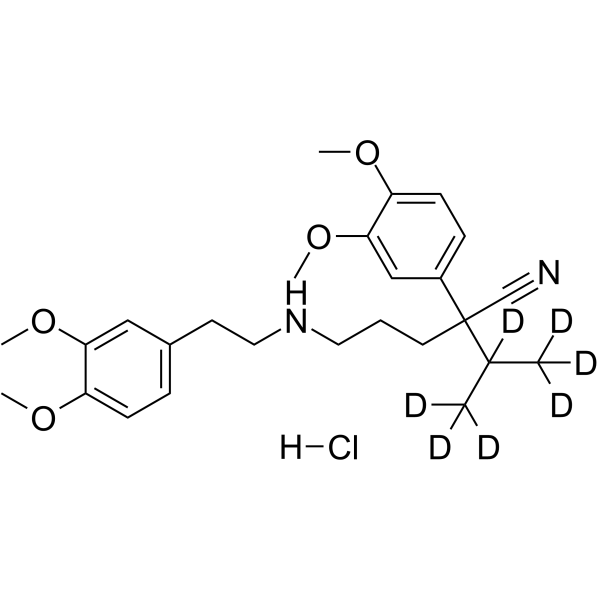
- HY-N6684
-
|
Vomitoxin
|
Others
|
Metabolic Disease
|
|
Deoxynivalenol, an orally active mycotoxin of the trichothecenes family, crosses the intestinal mucosa by a paracellular pathway through the tight junctions. The Deoxynivalenol transport is not affected by P-glycoprotein (PgP) or multidrug resistance-associated proteins (MRPs) inhibitors .
|
-
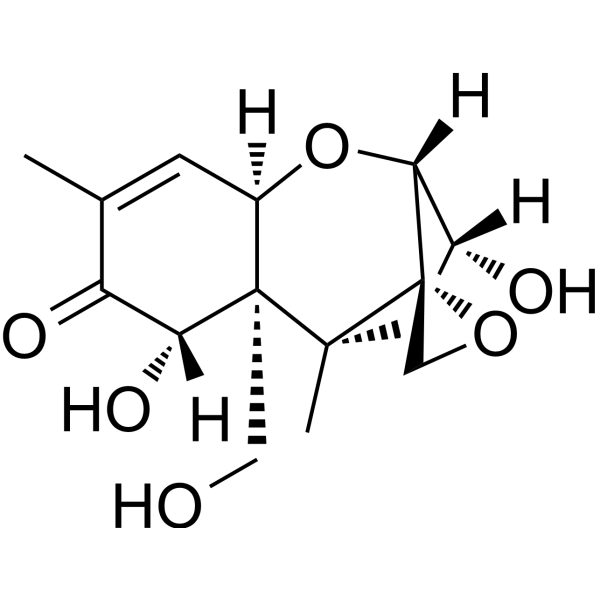
- HY-135328S
-
-
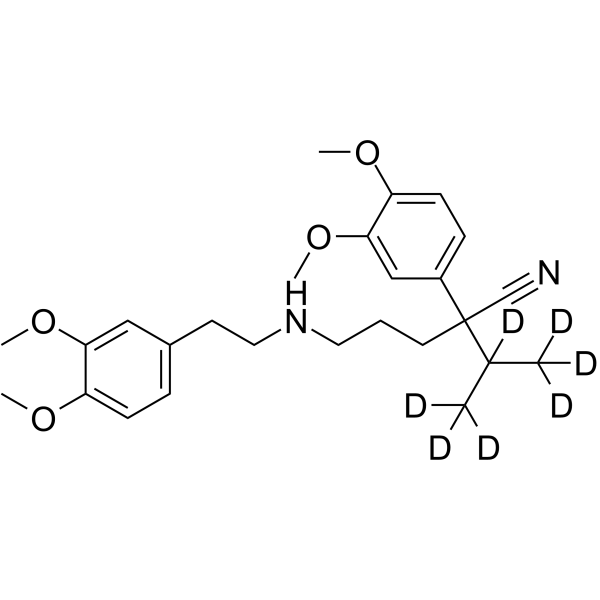
- HY-N10491
-
|
|
P-glycoprotein
|
Cancer
|
|
Spongionellol A is a MDR1 (p-glycoprotein) inhibitor. Spongionellol A has high cytotoxic activity and selectivity in prostate cancer cells by inducing caspase‑dependent apoptosis. Spongionellol A can be used in the research of cancers, such as prostate cancer .
|
-
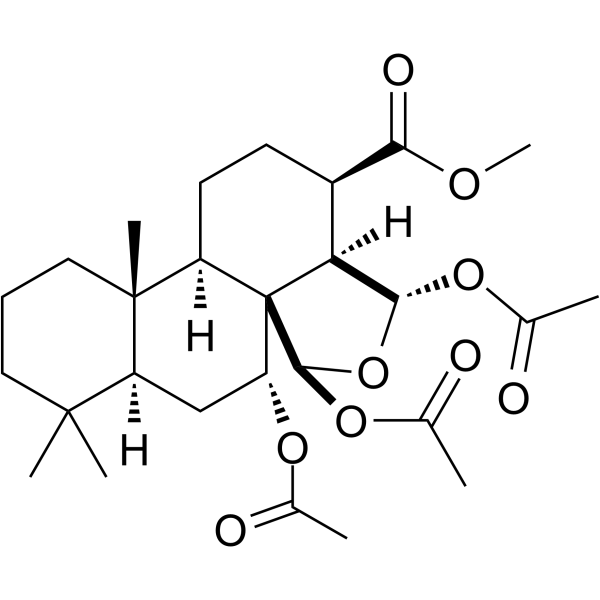
- HY-N4108
-
|
|
P-glycoprotein
|
Inflammation/Immunology
Cancer
|
|
Hypophyllanthin is a major lignan in Phyllanthus spp, with strong anti-inflammatory activity. Hypophyllanthin directly inhibits P-glycoprotein (P-gp) activity and did not interfere with multidrug resistance protein 2 (MRP2) activity .
|
-

- HY-162396
-
|
|
P-glycoprotein
|
Cancer
|
|
P-gp inhibitor 21 (Compound 56) is an inhibitor for P-glycoprotein (P-gp) transport, which reverses P-gp-mediated multidrug resistance (MDR) and exhibits antitumor efficacy in mice without significant cytotoxicity .
|
-
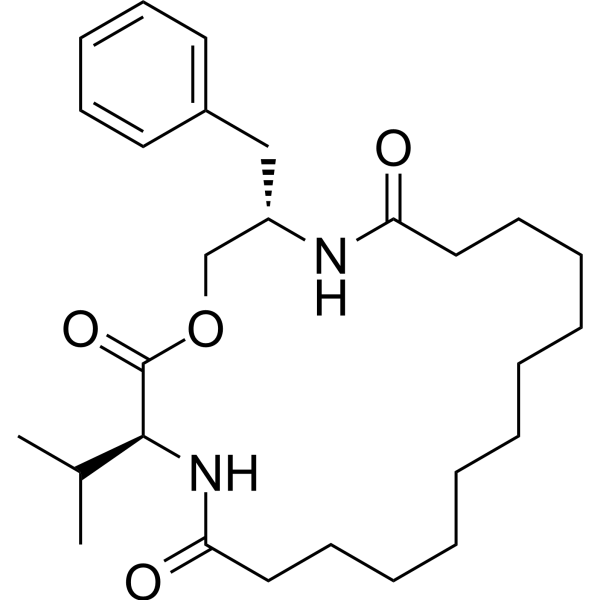
- HY-149360
-
|
|
P-glycoprotein
|
Cancer
|
|
P-gb-IN-1 (compound Ⅲ-8), a 2,5-disubstituted furan derivative, is a highly effective, broadspectrum P-glycoprotein (P-gp) inhibitor. P-gb-IN-1 displayed the reversal activity by inhibiting P-gp efflux. P-gb-IN-1 has a potent affinity to P-gp by forming H-bond interactions with residues Asn 721 and Met 986. P-gb-IN-1 possesses broad-spectrum reversal activity and low toxicity in MCF-7/ADR cells .
|
-
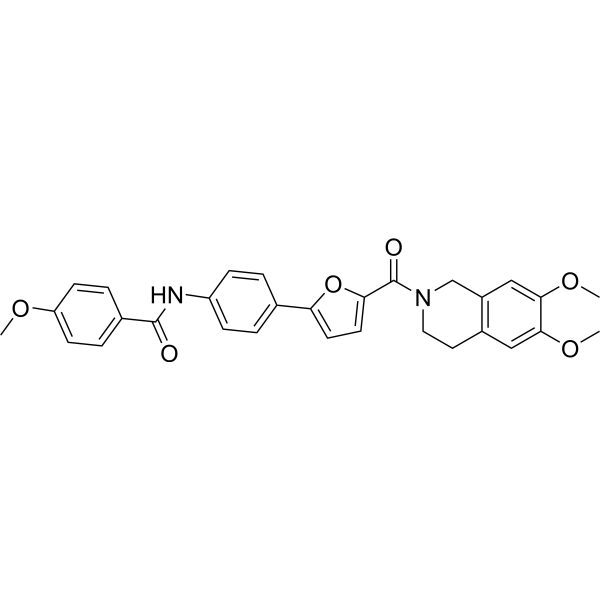
- HY-N3197
-
|
(+)-Neostenine
|
P-glycoprotein
|
Cancer
|
|
Neostenine is a stenine-type Stemona alkaloid, with antitussive activity. Neostenine is also a substrate of P-glycoprotein with high absorptive permeability in Caco-2 monolayer model. Neostenine also shows oral activity for intestinal application .
|
-
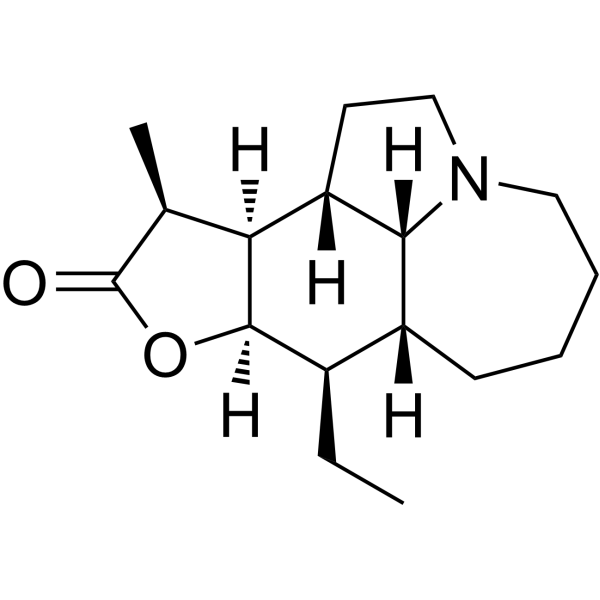
- HY-N10562
-
|
|
P-glycoprotein
|
Cancer
|
|
Mutabilol (compound 1) is a potent p-glycoprotein (P-gp) regulator. Mutabilol is a nature product could be isolated from Plectranthus mutabilis leaves. Mutabilol increases the P-gp expression in NCI-H460/R cells .
|
-
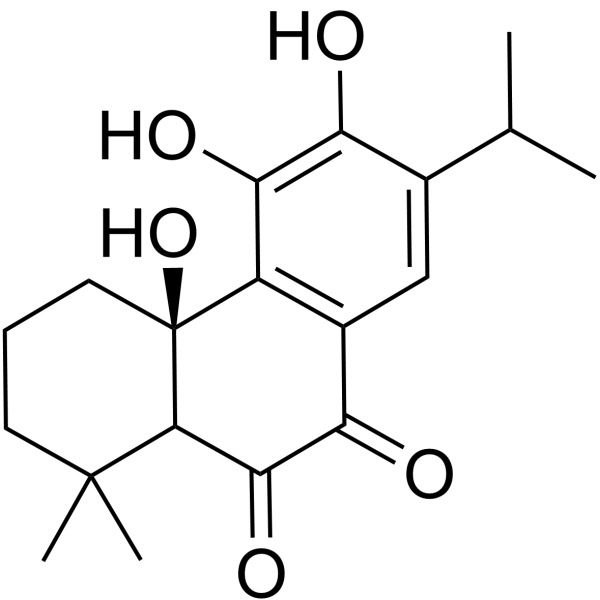
- HY-113805
-
|
|
P-glycoprotein
|
Cancer
|
|
MC70 is a potent and non-selective P-glycoprotein (P-gp) inhibitor with an EC50 of 0.69 µM. MC70 is an ABC transporters inhibitor and anticancer agent. MC70 interacts with ABCB1, ABCG2 and ABCC1 .
|
-
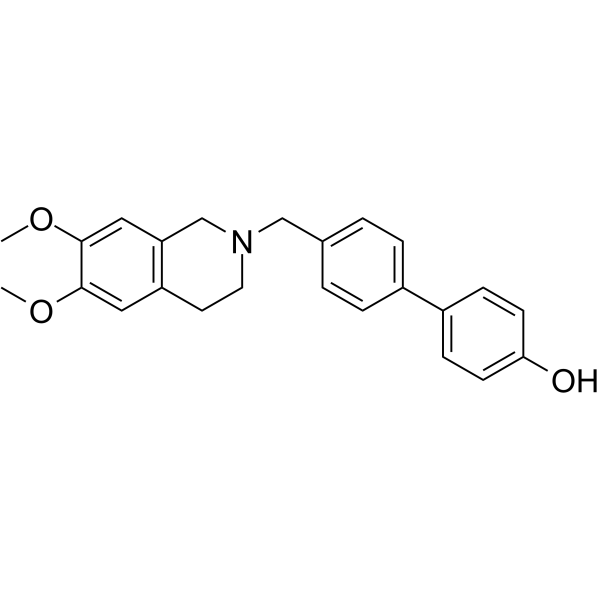
- HY-146391
-
|
|
P-glycoprotein
|
Cancer
|
|
P-gp inhibitor 4 (Compound 8b) is a selective P-glycoprotein modulator with an EC50 of 94 nM. P-gp inhibitor 4 increases agent transport across gastro-intestinal barrier and recovers doxorubicin toxicity in multidrug resistant cancer cells .
|
-
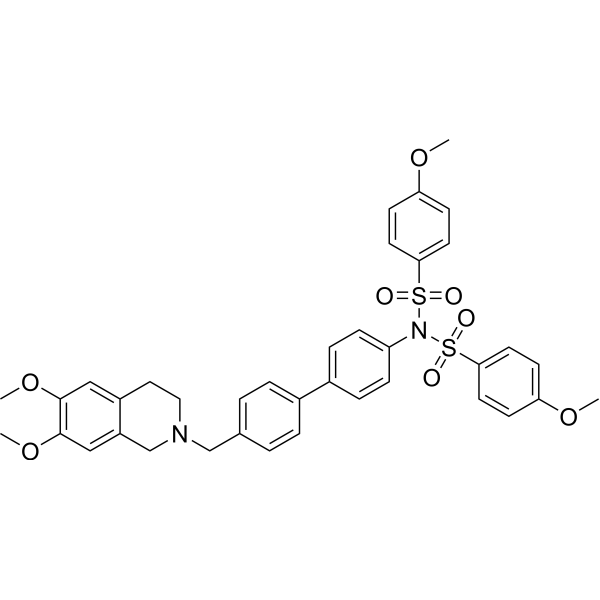
- HY-N2947
-
|
|
P-glycoprotein
|
Infection
Inflammation/Immunology
|
|
Boeravinone B, a dual inhibitor of NorA bacterial efflux pump of Staphylococcus aureus and human P-Glycoprotein, reduces the biofilm formation and intracellular invasion of bacteria. Boeravinone B act as anti-aging and anti-apoptosis phyto-molecules during oxidative stress .
|
-
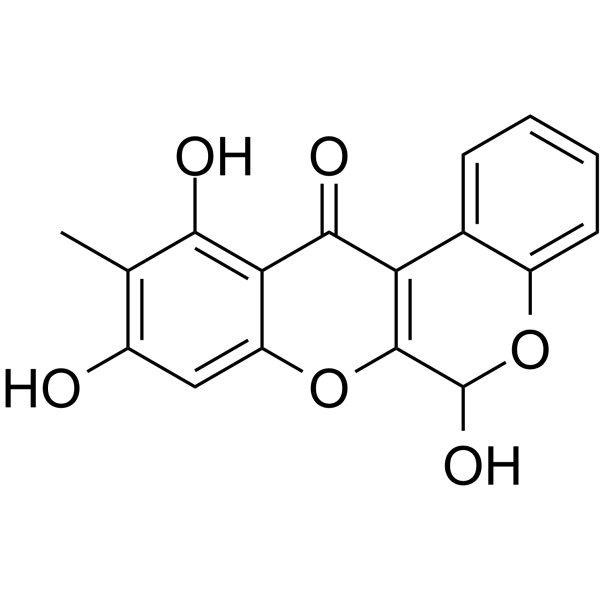
- HY-11018
-
-
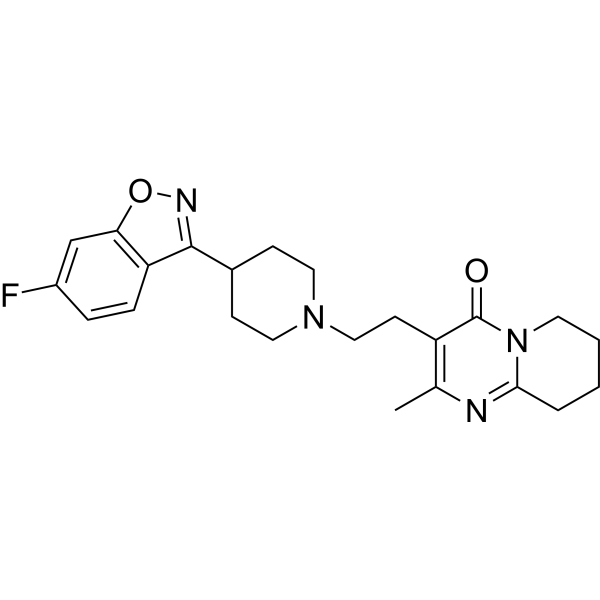
- HY-A0064
-
|
(±)-Verapamil hydrochloride; CP-16533-1 hydrochloride
|
Calcium Channel
P-glycoprotein
Cytochrome P450
|
Cardiovascular Disease
|
|
Verapamil hydrochloride ((±)-Verapamil hydrochloride) is a calcium channel blocker and a potent and orally active first-generation P-glycoprotein (P-gp) inhibitor. Verapamil hydrochloride also inhibits CYP3A4. Verapamil hydrochloride has the potential for high blood pressure, heart arrhythmias and angina research .
|
-

- HY-14275
-
|
(±)-Verapamil; CP-16533-1
|
Calcium Channel
P-glycoprotein
Cytochrome P450
|
Metabolic Disease
Cancer
|
|
Verapamil ((±)-Verapamil) is a calcium channel blocker and a potent and orally active first-generation P-glycoprotein (P-gp) inhibitor. Verapamil also inhibits CYP3A4. Verapamil has the potential for high blood pressure, heart arrhythmias and angina research .
|
-
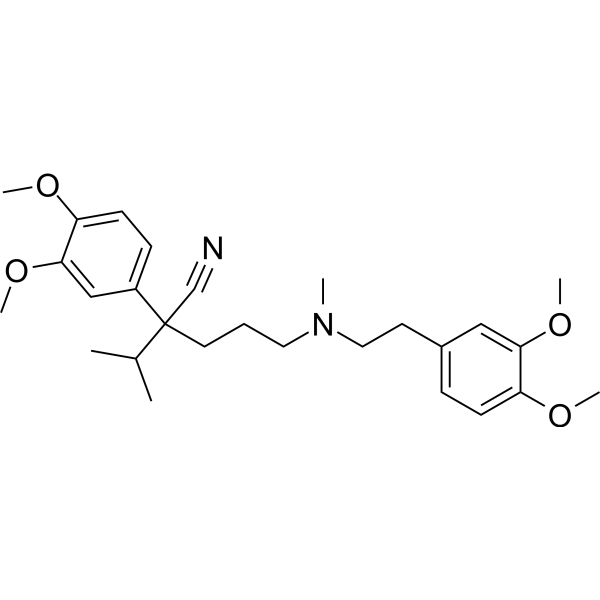
- HY-126940
-
|
|
Reactive Oxygen Species
P-glycoprotein
Apoptosis
|
Cancer
|
|
Furanodiene is a natural terpenoid isolated from Rhizoma Curcumae. Furanodiene plays anti-cancer effects through anti-angiogenesis and inducing ROS production, DNA strand breaks and apoptosis. Furanodiene suppresseed efflux transporter Pgp (P-glycoprotein) function and reduced Pgp protein level .
|
-
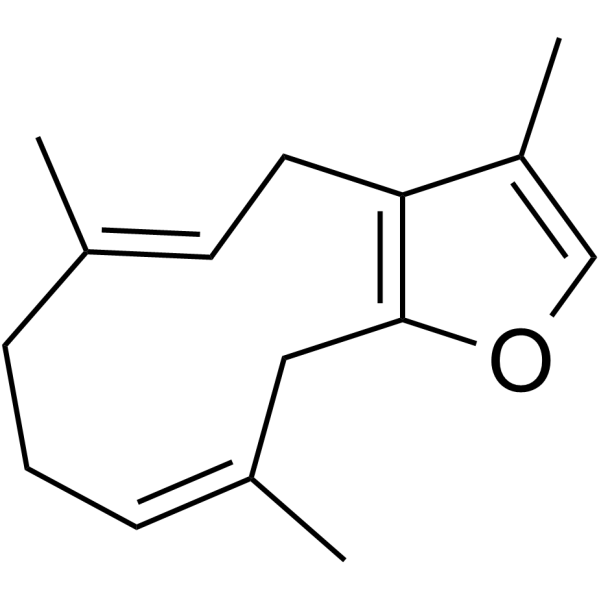
- HY-162369
-
|
|
P-glycoprotein
|
Cancer
|
|
PID-9 is a P-glycoprotein inhibitor. PID-9 has multidrug resistance (MDR) reversal activity (IC50 = 0.1338 μM) and low toxicity. PID-9 inhibits the transport function of P-gp without downregulating P-gp expression .
|
-
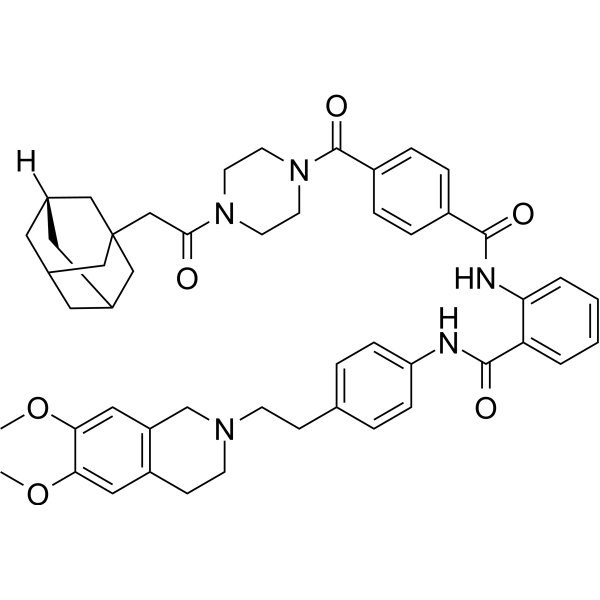
- HY-11018A
-
-
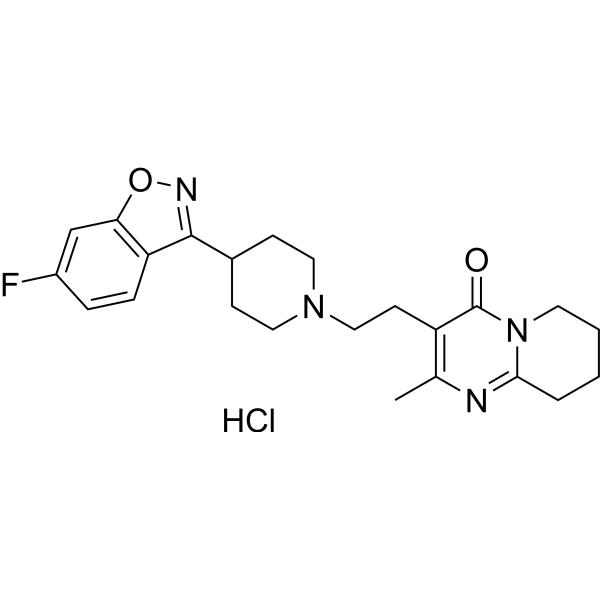
- HY-135336S
-
|
(R)-(+)-Verapamil-d7 hydrochloride
|
Isotope-Labeled Compounds
P-glycoprotein
Apoptosis
|
Cancer
|
|
(R)-Verapamil-d7 (hydrochloride) is a deuterium labeled (R)-Verapamil hydrochloride. (R)-Verapamil hydrochloride ((R)-(+)-Verapamil hydrochloride) is a P-Glycoprotein inhibitor. (R)-Verapamil hydrochloride blocks MRP1 mediated transport, resulting in chemosensitization of MRP1-overexpressing cells to anticancer agents[1][2].
|
-
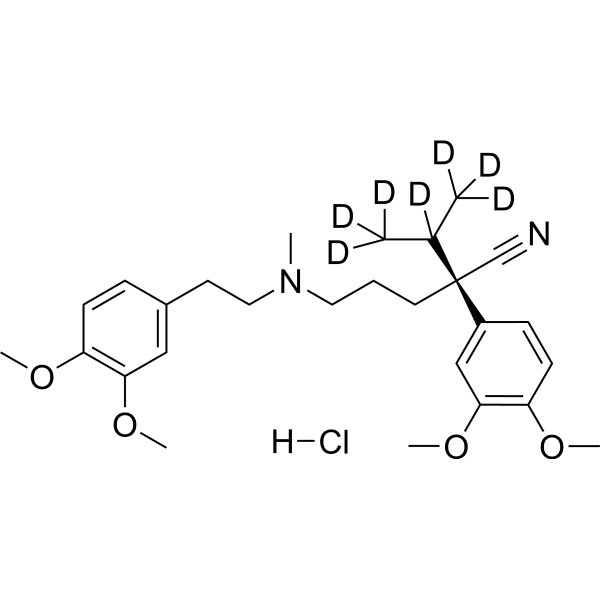
- HY-11018B
-
-
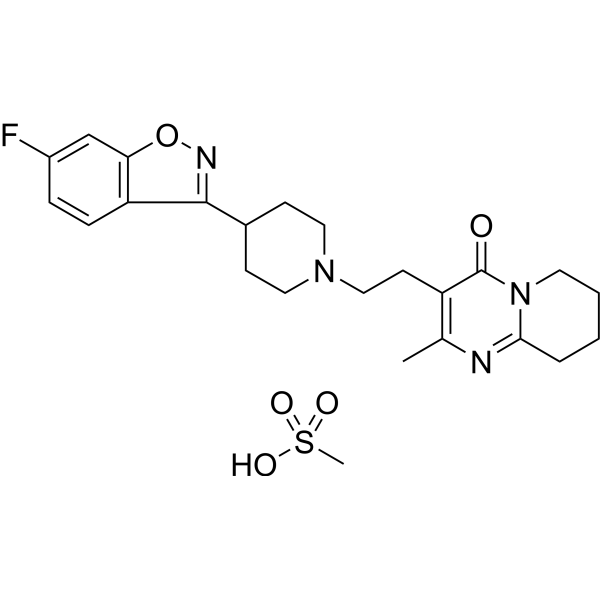
- HY-N10492
-
|
|
P-glycoprotein
|
Cancer
|
|
Spongionellol A analog 1, an analog of Spongionellol A (HY-10491), is a MDR1 (p-glycoprotein) inhibitor. Spongionellol A analog 1 has high cytotoxic activity and selectivity in prostate cancer cells by inducing caspase‑dependent apoptosis. Spongionellol A analog 1 can be used in the research of cancers, such as prostate cancer .
|
-
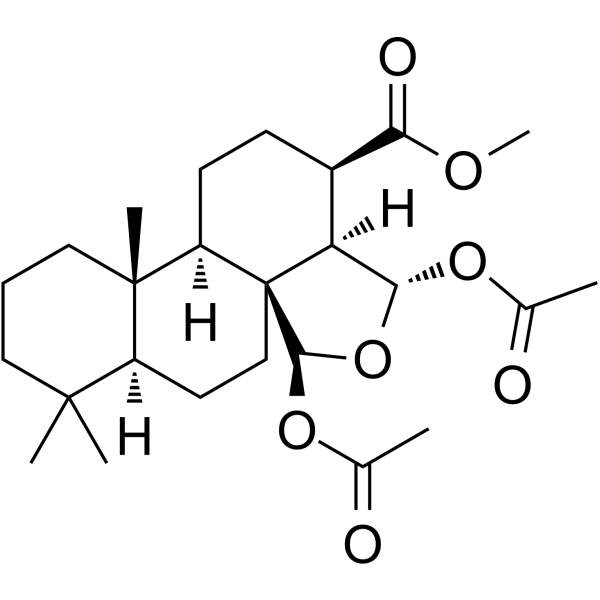
- HY-N3028
-
|
|
Microtubule/Tubulin
|
Cancer
|
|
Taccalonolide B is microtubule stabilizer isolated from Tacca plantaginea, with antitumor activity. Taccalonolide B is effective in vitro against cell lines that overexpress P-glycoprotein (Pgp) and multidrug-resistance protein (MRP7). Taccalonolide B inhibits growth of SK-OV-3 cells with an IC50 of 208 nM .
|
-
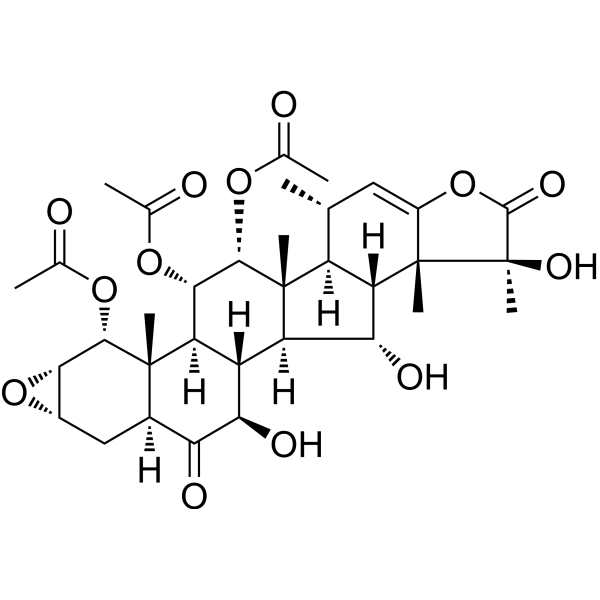
- HY-149981
-
|
|
P-glycoprotein
|
Cancer
|
P-gp inhibitor 13 is a P-gp inhibitor. P-gp inhibitor 13 can reverse P-glycoprotein-mediated paclitaxel resistance in A2780/T cell. P-gp inhibitor 13 can be used for the research of advanced acute myeloid leukemia .
|
-
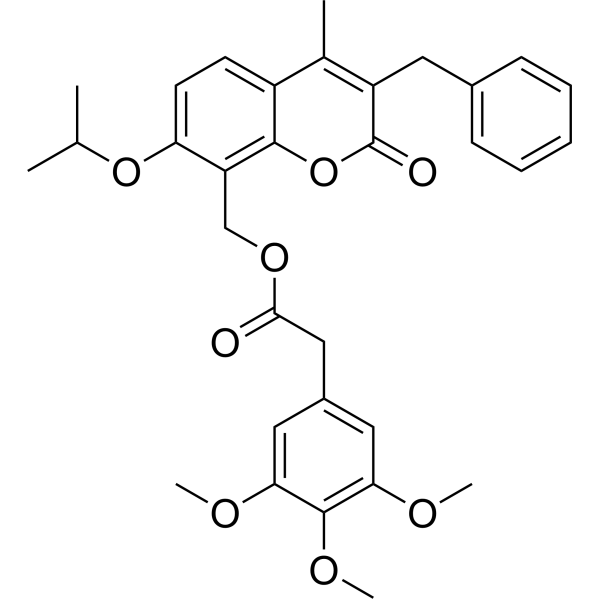
- HY-B0777
-
|
CL301423
|
Antibiotic
BCRP
P-glycoprotein
Parasite
|
Infection
|
|
Moxidectin (CL301423) is an orally active macrolide (ML) anthelmintic for the prevention and control of heartworms and roundworms. Moxidectin is also a substrate of BCRP and P-glycoprotein (P-gp) in vivo, and is secreted into breast milk and effluxed from the host and parasite mediated by Bcrp1 and P-gp. This may be related to the presence of chemical residues in milk .
|
-
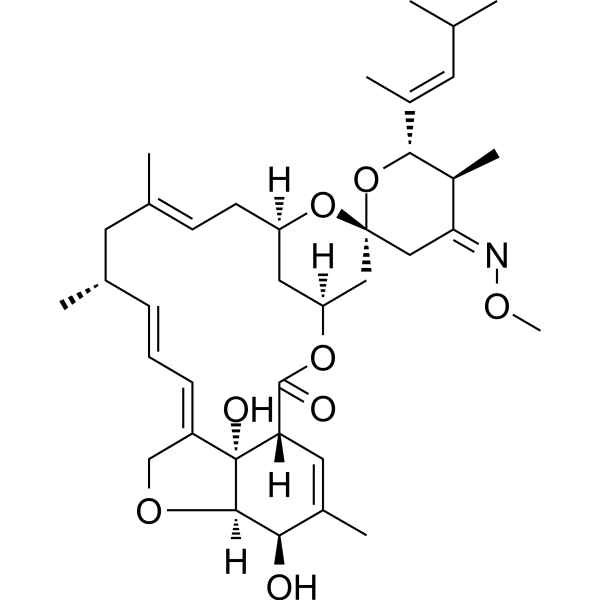
- HY-N0069
-
|
Solamargin; δ-Solanigrine
|
P-glycoprotein
Apoptosis
|
Cancer
|
|
Solamargine, a derivative from the steroidal solasodine in Solanum species, exhibits anticancer activities in numerous types of cancer. Solamargine induces non-selective cytotoxicity and P-glycoprotein inhibition. Solamargine significantly inhibits migration and invasion of HepG2 cells by down-regulating MMP-2 and MMP-9 expression and activity .
|
-
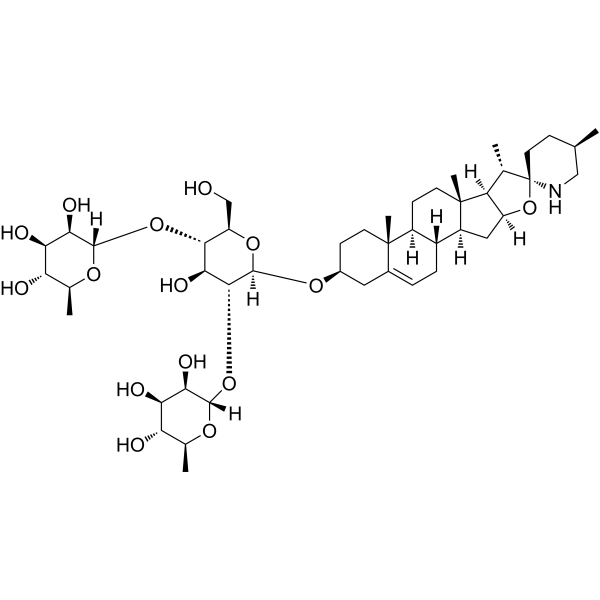
- HY-110232
-
|
R 64 766-d4
|
5-HT Receptor
Dopamine Receptor
P-glycoprotein
|
Neurological Disease
|
|
Risperidone-d4 is the deuterium labeled Risperidone. Risperidone is a serotonin 5-HT2 receptor blocker, P-Glycoprotein inhibitor and potent dopamine D2 receptor antagonist, with Kis of 4.8, 5.9 nM for 5-HT2A and dopamine D2 receptor, respectively.
|
-
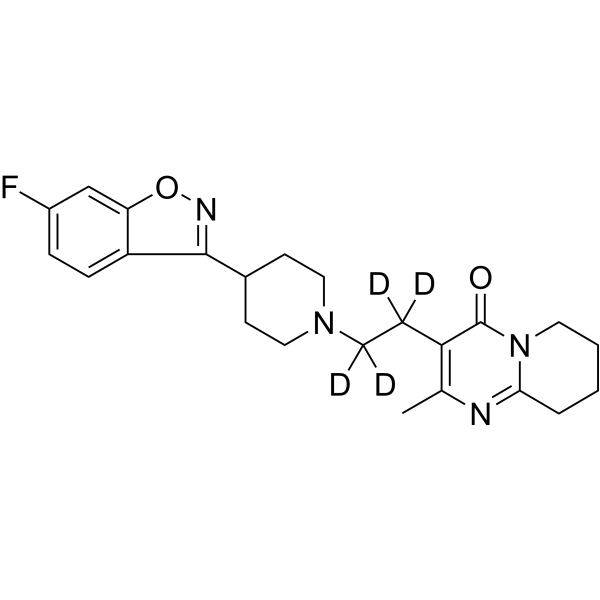
- HY-16397
-
|
Phenethylbiguanide
|
Mitochondrial Metabolism
AMPK
Apoptosis
|
Metabolic Disease
Cancer
|
|
Phenformin (1-phenethylbiguanide) is an orally active antidiabetic and anticancer agent. Phenformin has an incidence of associated lactic acidosis. Phenformin acts through acting AMPK activation and blocking mTOR pathway. Phenformin is also a substrate of P-glycoprotein (P-gp), and an OXPHOS inhibitor. Phenformin induces cancer cell apoptosis .
|
-
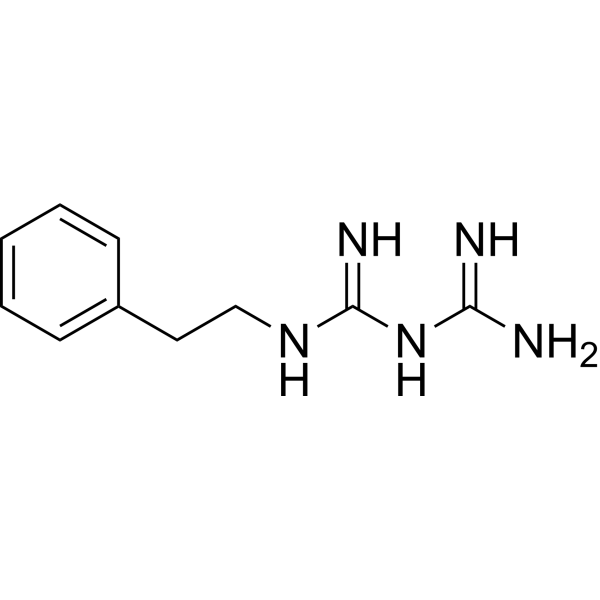
- HY-149053
-
|
|
P-glycoprotein
|
Cancer
|
|
OY-101 is an orally active, potent and specific P-glycoprotein (P-gp) inhibitor. OY-101 can sensitize drug-resistant tumors and effectively reverse tumor multidrug resistance. OY-101 is improvements in water-solubility, cytotoxicity, and reversal activity compared to Tetrandrine (HY-13764) .
|
-
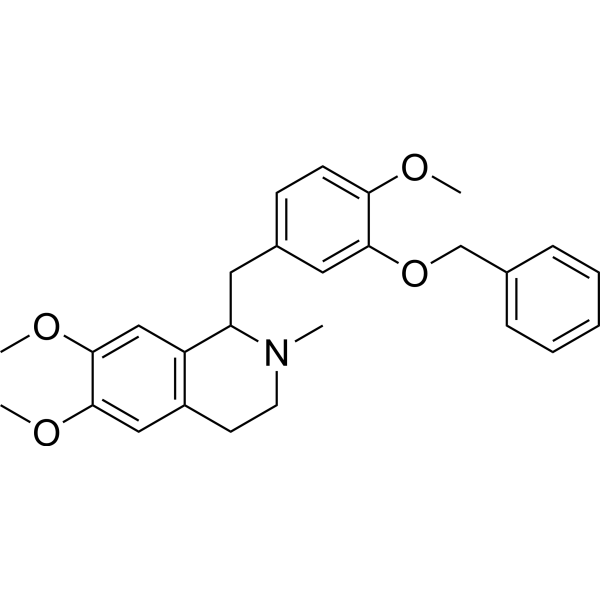
- HY-A0064S
-
|
(±)-Verapamil-d3 hydrochloride; CP-16533-1-d3 hydrochloride
|
Isotope-Labeled Compounds
Calcium Channel
P-glycoprotein
Cytochrome P450
|
Cardiovascular Disease
|
|
Verapamil-d3 (hydrochloride) is the deuterium labeled Verapamil hydrochloride. Verapamil hydrochloride ((±)-Verapamil hydrochloride) is a calcium channel blocker and a potent and orally active first-generation P-glycoprotein (P-gp) inhibitor. Verapamil hydrochloride also inhibits CYP3A4. Verapamil hydrochloride has the potential for high blood pressure, heart arrhythmias and angina research[1][2][3].
|
-
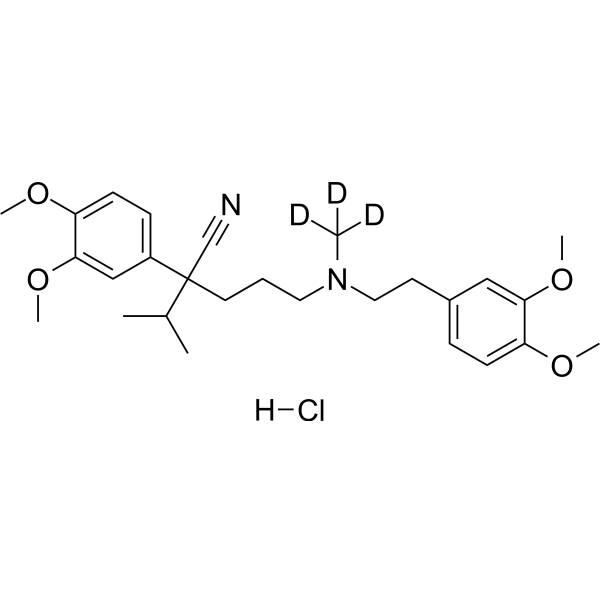
- HY-135194
-
|
|
Drug Metabolite
|
Others
|
|
Risperidone E-oxime is an impurity of Risperidone . Risperidone is a serotonin 5-HT2 receptor blocker, P-Glycoprotein inhibitor and potent dopamine D2 receptor antagonist, with Kis of 4.8, 5.9 nM for 5-HT2A and dopamine D2 receptor, respectively .
|
-
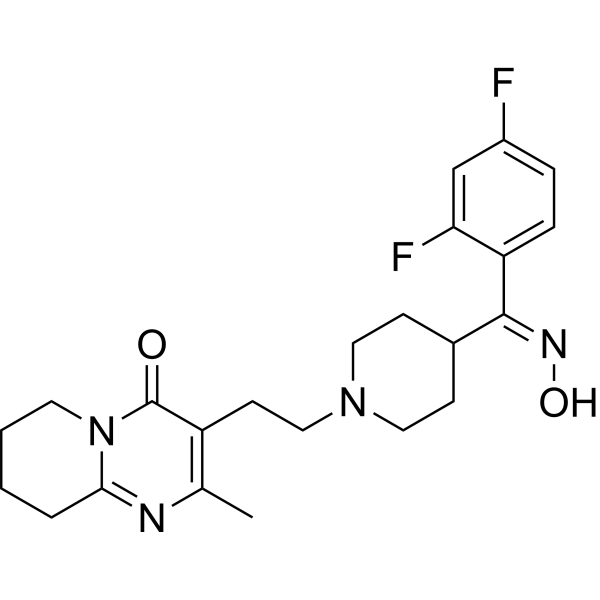
- HY-132189
-
|
R101933
|
P-glycoprotein
|
Cancer
|
|
Laniquidar (R101933) is a noncompetitive, third generation P-glycoprotein (P-gp) inhibitor with an IC50 of 0.51 μM. Laniquidar can be used for modulating multidrug resistance transporters . Laniquidar can also be used for studying acute myeloid leukemia (AML) and myelodysplastic syndrome (MDS) . Laniquidar has limited oral bioavailability .
|
-
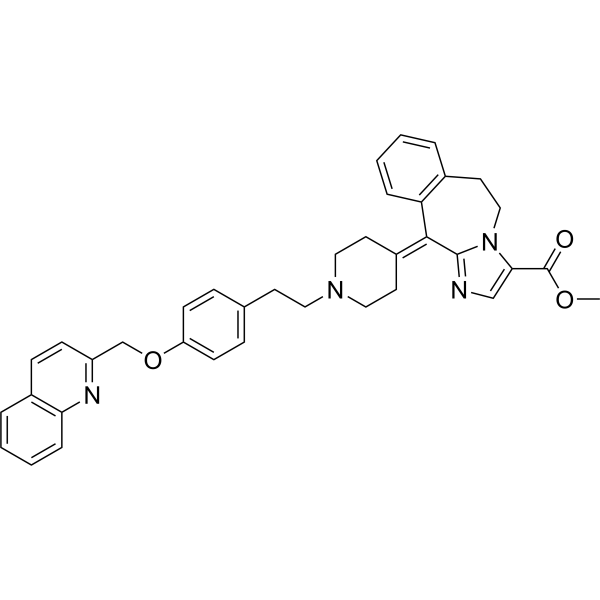
- HY-14275S1
-
-
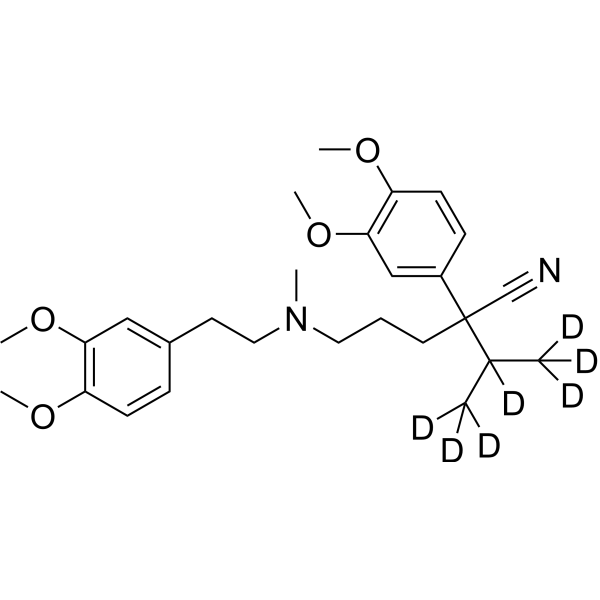
- HY-A0064R
-
|
(±)-Verapamil hydrochloride (Standard); CP-16533-1 hydrochloride (Standard)
|
Calcium Channel
P-glycoprotein
Cytochrome P450
|
Cardiovascular Disease
Cancer
|
|
Verapamil (hydrochloride) (Standard) is the analytical standard of Verapamil (hydrochloride). This product is intended for research and analytical applications. Verapamil hydrochloride ((±)-Verapamil hydrochloride) is a calcium channel blocker and a potent and orally active first-generation P-glycoprotein (P-gp) inhibitor. Verapamil hydrochloride also inhibits CYP3A4. Verapamil hydrochloride has the potential for high blood pressure, heart arrhythmias and angina research .
|
-
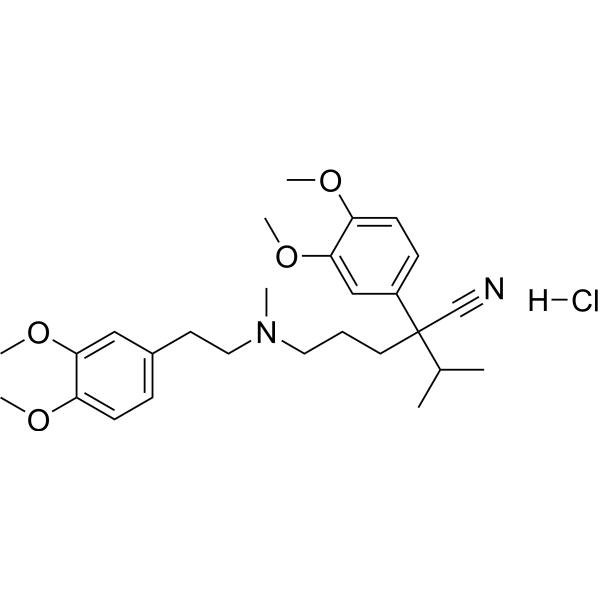
- HY-125374
-
|
XRP9881
|
Apoptosis
|
Cancer
|
|
Larotaxel (XRP9881) is a taxane analogue with preclinical activity against taxane-resistant breast cancer. Larotaxel (XRP9881) exerts its cytotoxic effect by promoting tubulin assembly and stabilizing microtubules, ultimately leading to cell death by apoptosis. It presents the ability to cross the blood brain barrier and has a much lower affinity for P-glycoprotein 1 than Docetaxel .
|
-
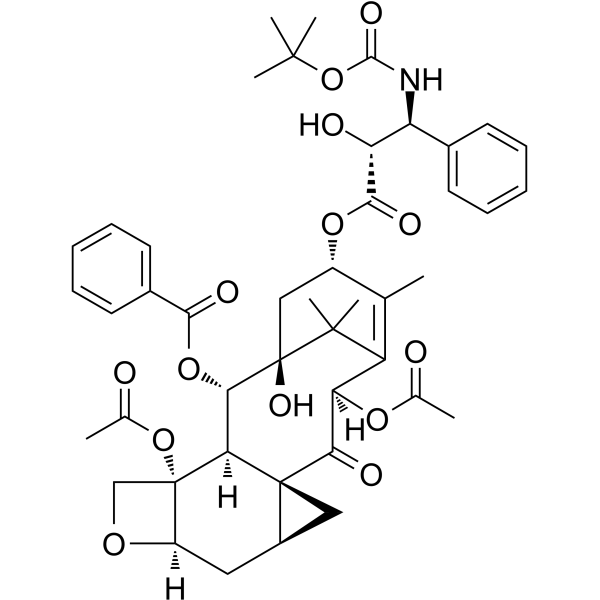
- HY-17367
-
|
BMS-232632
|
HIV
HIV Protease
SARS-CoV
Cytochrome P450
P-glycoprotein
Endogenous Metabolite
|
Infection
Cancer
|
|
Atazanavir (BMS-232632), a highly selective HIV-1 protease inhibitor, is the first protease inhibitor approved for once-daily administration . Atazanavir (BMS-232632) is a substrate and inhibitor of CYP3A4, and an inhibitor and inducer of P-glycoprotein (P-gp) . Atazanavir is also a SARS-CoV 3CL pro inhibitor with an IC50 of 3.49 μM .
|
-
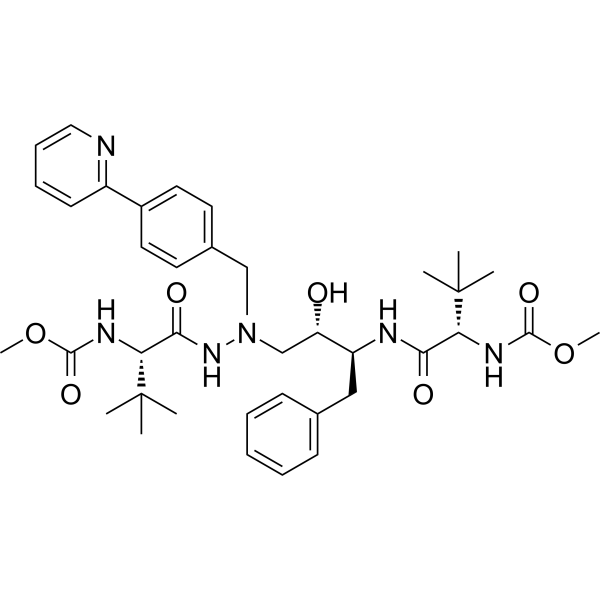
- HY-17367A
-
|
BMS-232632 sulfate
|
HIV
HIV Protease
SARS-CoV
Cytochrome P450
P-glycoprotein
Endogenous Metabolite
|
Infection
Cancer
|
|
Atazanavir (BMS-232632) sulfate, a highly selective HIV-1 protease inhibitor, is the first protease inhibitor approved for once-daily administration . Atazanavir sulfate is a substrate and inhibitor of CYP3A4, and an inhibitor and inducer of P-glycoprotein (P-gp) . Atazanavir sulfate is also a SARS-CoV 3CL pro inhibitor with an IC50 of
3.49 μM .
|
-
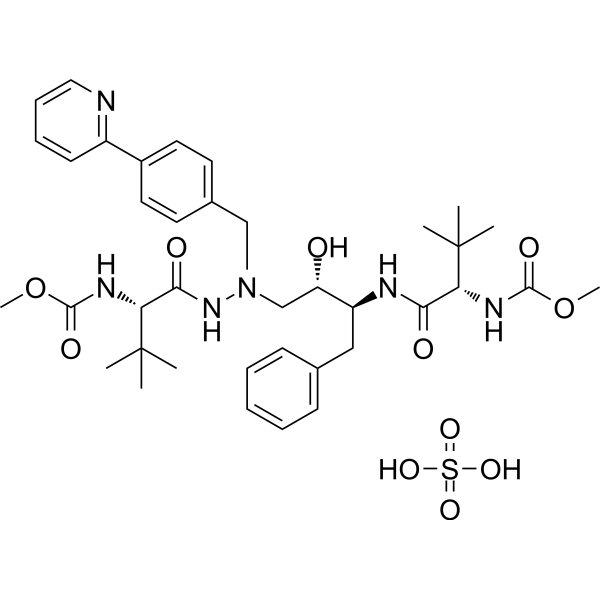
- HY-155032
-
|
|
P-glycoprotein
|
Cancer
|
|
P-gp inhibitor 15 (compound 7a) is a nonsubstrate inhibitor of P-glycoprotein (Pgp). P-gp inhibitor 15 inhibits Pgp-ATPase activity,and interfers Pgp-mediated Rhodamine123 efflux. P-gp inhibitor 15 also enhances the inhibitory efficacy of Paclitaxel (HY-B0015),inhibits tumor progress in nude mice KBV xenograft tumors model .
|
-
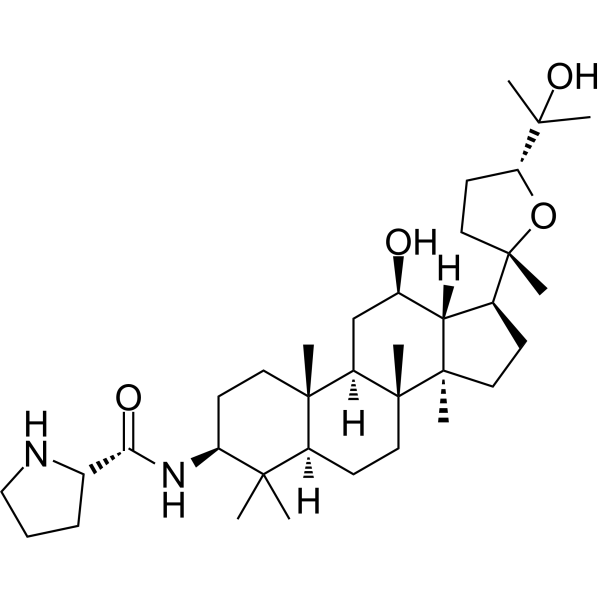
- HY-157876
-
|
|
P-glycoprotein
BCRP
|
Cancer
|
|
Anticancer agent 191 (Compound 2) is a derivative of probenecid (HY-B0545). As a cancer cell efflux inhibitor, Anticancer agent 191 is designed to inhibit P-glycoprotein (P-gp), breast cancer resistance protein (BCRP), and/or multiple multidrug resistance proteins (MRPs). Anticancer agent 191 increases the accumulation of vinblastine in cancer cells, which is used for cancer research .
|
-
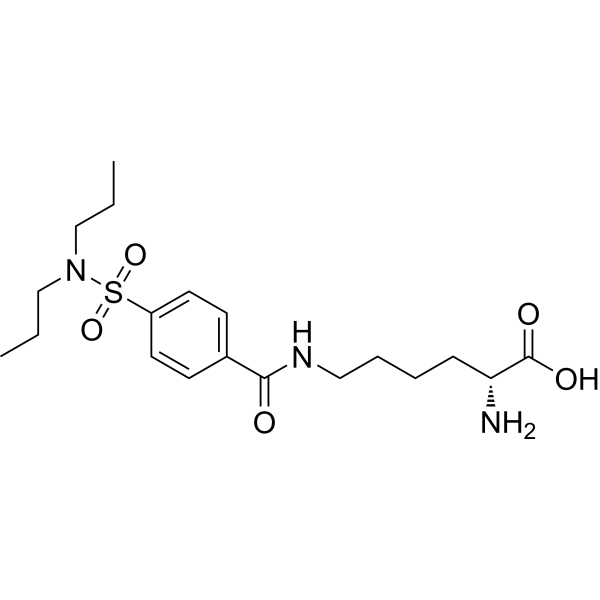
- HY-B0777R
-
|
CL301423 (Standard)
|
Antibiotic
BCRP
P-glycoprotein
Parasite
|
Infection
|
|
Moxidectin (Standard) is the analytical standard of Moxidectin. This product is intended for research and analytical applications. Moxidectin (CL301423) is an orally active macrolide (ML) anthelmintic for the prevention and control of heartworms and roundworms. Moxidectin is also a substrate of BCRP and P-glycoprotein (P-gp) in vivo, and is secreted into breast milk and effluxed from the host and parasite mediated by Bcrp1 and P-gp. This may be related to the presence of chemical residues in milk .
|
-
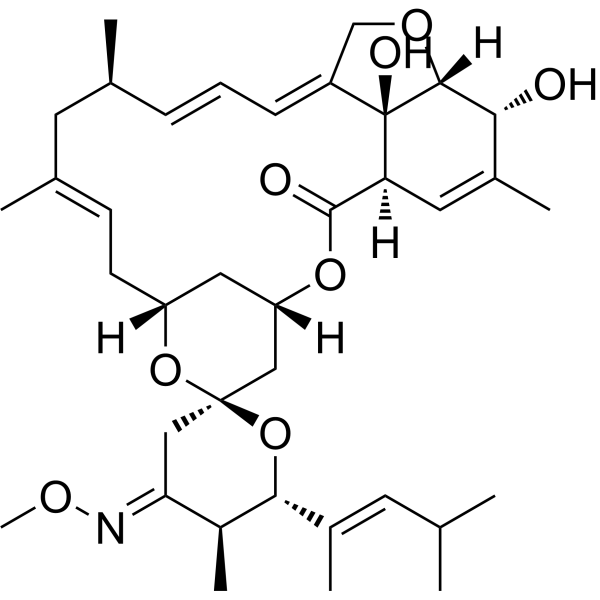
- HY-15206
-
|
Glyburide
|
Potassium Channel
Mitochondrial Metabolism
Autophagy
CFTR
P-glycoprotein
|
Metabolic Disease
|
|
Glibenclamide (Glyburide) is an orally active ATP-sensitive K + channel (KATP) inhibitor and can be used for the research of diabetes and obesity . Glibenclamide inhibits P-glycoprotein. Glibenclamide directly binds and blocks the SUR1 subunits of KATP and inhibits the cystic fibrosis transmembrane conductance regulator protein (CFTR) . Glibenclamide interferes with mitochondrial bioenergetics by inducing changes on membrane ion permeability . Glibenclamide can induce autophagy .
|
-
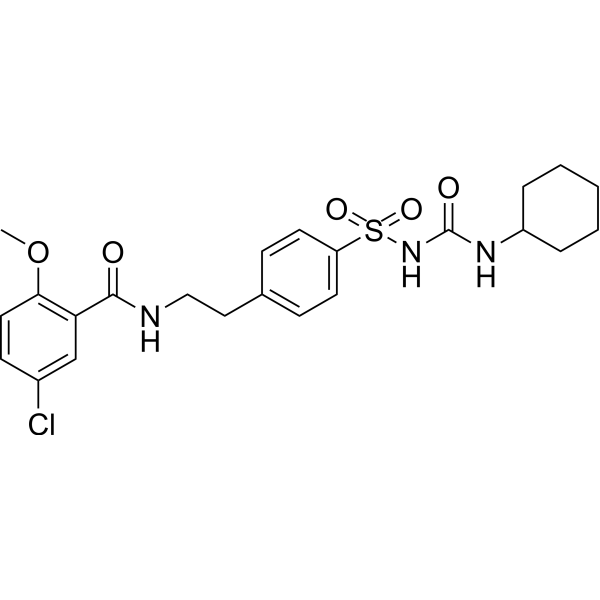
- HY-N2416
-
|
|
Microtubule/Tubulin
Apoptosis
|
Cancer
|
|
Taccalonolide A is a microtubule stabilizer, which is a steroid isolated from Tacca chantrieri, with cytotoxic and antimalarial activities . Taccalonolide A causes G2-M accumulation, Bcl-2 phosphorylation and initiation of apoptosis . Taccalonolide A is effective in vitro against cell lines that overexpress P-glycoprotein (Pgp) and multidrug resistance protein 7 (MRP7), with an IC50 of 622 nM for SK-OV-3 cells .
|
-

- HY-N2453
-
|
|
PPAR
NF-κB
P-glycoprotein
|
Inflammation/Immunology
Cancer
|
|
Convallatoxin is a cardiac glycoside isolated from Adonis amurensis Regel et Radde. Convallatoxin ameliorates colitic inflammation via activation of PPARγ and suppression of NF-κB. Convallatoxin is a P-glycoprotein (P-gp) substrate and recognized Val982 as an important amino acid involved in its transport. Convallatoxin is an enhancer of ligand-induced MOR endocytosis with high potency and efficacy. Anti-inflammatory and anti-proliferative properties .
|
-
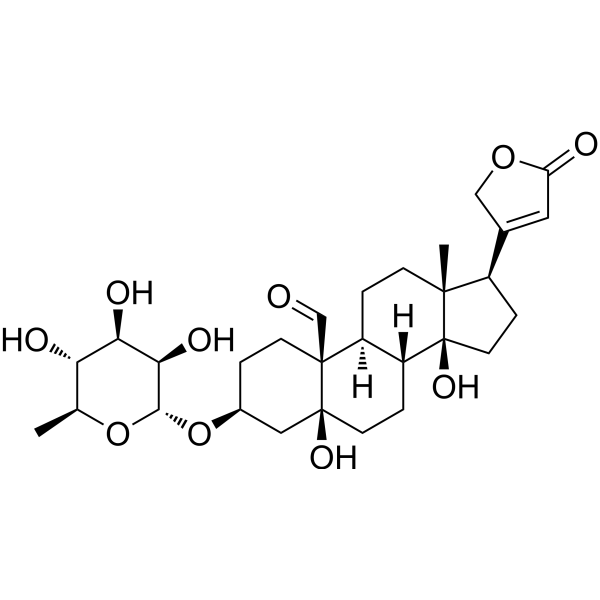
- HY-A0064S1
-
|
(±)-Verapamil-d6 hydrochloride; CP-16533-1-d6 hydrochloride
|
Isotope-Labeled Compounds
|
Cardiovascular Disease
|
|
Verapamil-d6 (CP-16533-1-d6) hydrochloride is the deuterium labled Verapamil (hydrochloride) (HY-A0064). Verapamil hydrochloride ((±)-Verapamil hydrochloride) is a calcium channel blocker and a potent and orally active first-generation P-glycoprotein (P-gp) inhibitor. Verapamil hydrochloride also inhibits CYP3A4. Verapamil hydrochloride has the potential for high blood pressure, heart arrhythmias and angina research .
|
-
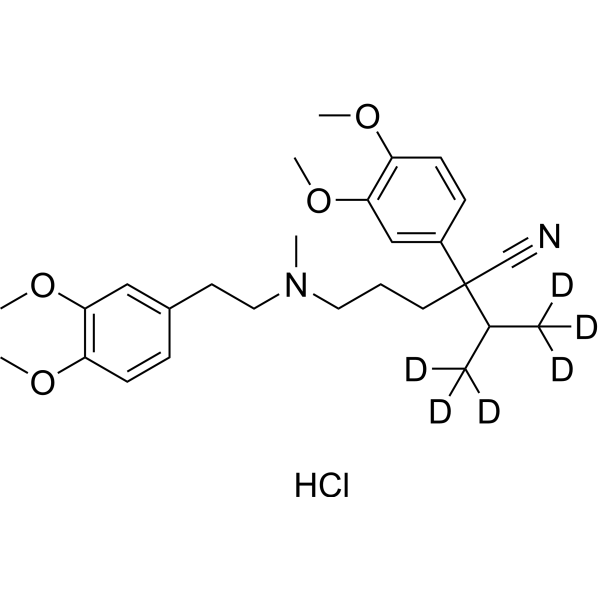
- HY-11018S2
-
|
R 64 766-d6
|
5-HT Receptor
Dopamine Receptor
P-glycoprotein
|
Neurological Disease
|
|
Risperidone-d6 (R 64 766-d6) is the deuterium labeled Risperidone (HY-11018). Risperidone is a serotonin 5-HT2 receptor blocker, P-Glycoprotein inhibitor and potent dopamine D2 receptor antagonist, with Kis of 4.8, 5.9 nM for 5-HT2A and dopamine D2 receptor, respectively .
|
-
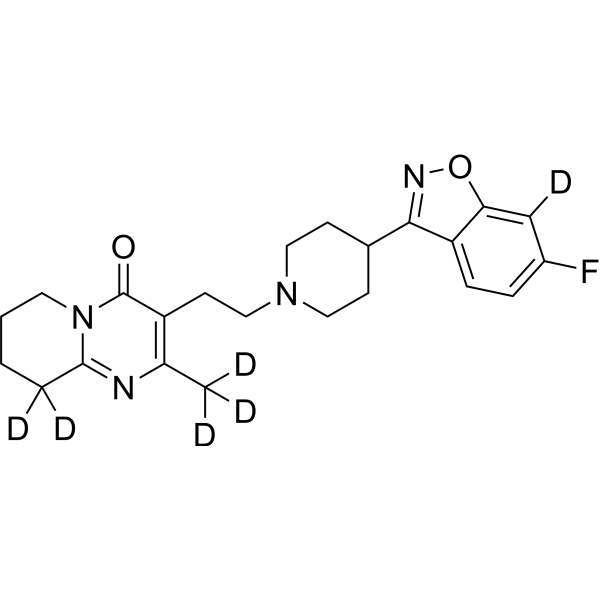
- HY-150565
-
|
|
P-glycoprotein
|
Cancer
|
|
P-gp inhibitor 5 is a potent P-glycoprotein (P-gp) inhibitor. P-gp inhibitor 5 has antiproliferative activity against certain cancer cell lines. P-gp inhibitor 5 is effective in reversing the multidrug resistance (MDR) phenotype in ABCB1/Flp-In TM-293 and KBvin cells by restoring their sensitivity to Vincristine (HY-N0488A) and Paclitaxel (HY-B0015) .
|
-

- HY-161260
-
|
|
P-glycoprotein
|
Cancer
|
|
P-gp inhibitor 20 (compound H27) is a low cytotoxicity P-glycoprotein (P-gp) inhibitor. P-gp inhibitor 20 inhibits the efflux function of P-gp in a dose-dependent manner (without affecting the expression of P-gp), thereby reversing the multidrug resistance (MDR) of MCF-7/ADR cells, with an IC50 value of 46.6 nM. P-gp inhibitor 20 can be used for cancer research .
|
-
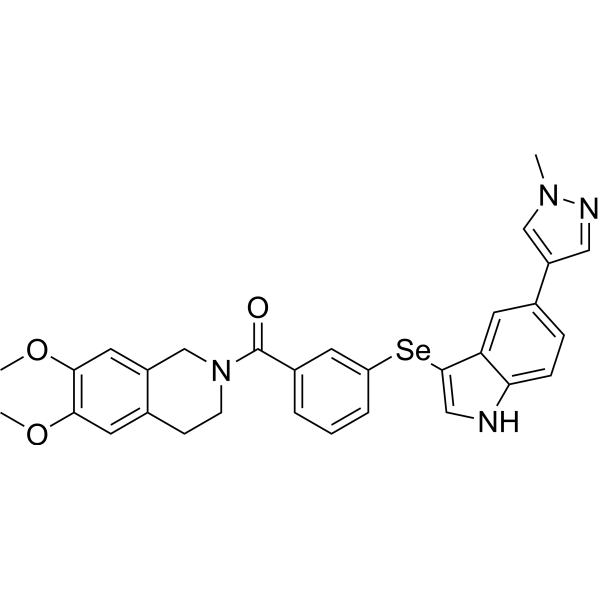
- HY-17367S3
-
-
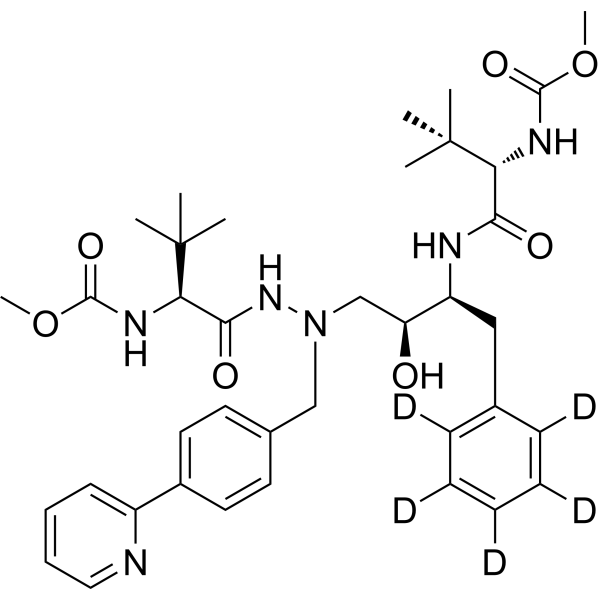
- HY-17367S2
-
-
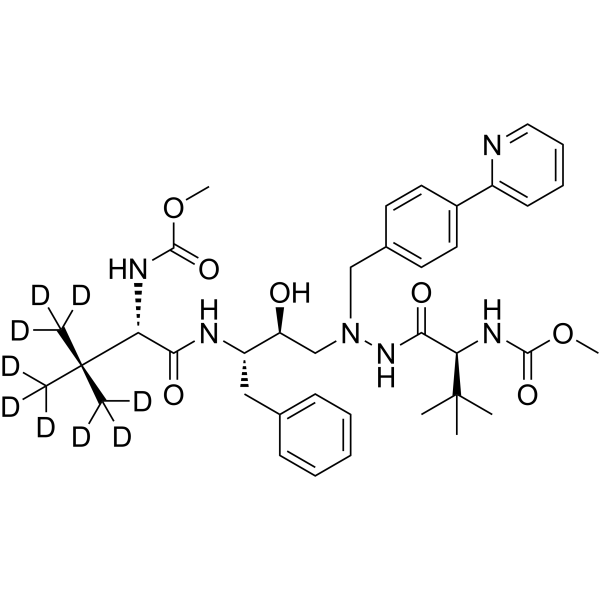
- HY-17367S4
-
-
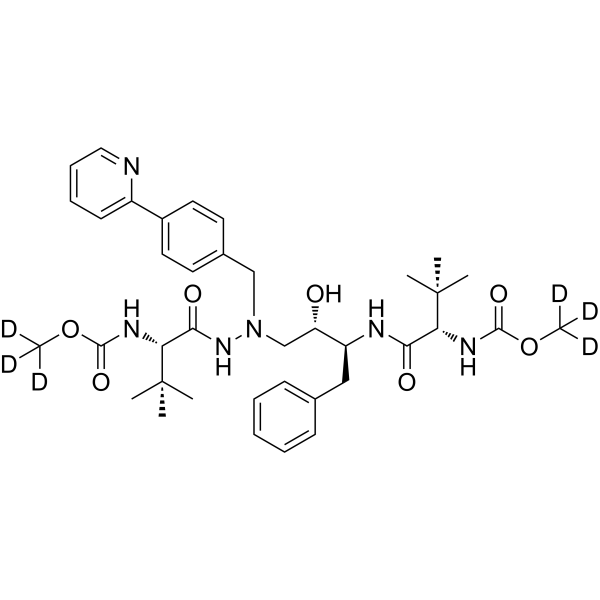
- HY-15206S
-
|
|
Isotope-Labeled Compounds
Potassium Channel
Mitochondrial Metabolism
Autophagy
CFTR
P-glycoprotein
|
Metabolic Disease
|
|
Glyburide-d11 is the deuterium labeled Glibenclamide. Glibenclamide (Glyburide) is an orally active ATP-sensitive K+ channel (KATP) inhibitor and can be used for the research of diabetes and obesity[1]. Glibenclamide inhibits P-glycoprotein. Glibenclamide directly binds and blocks the SUR1 subunits of KATP and inhibits the cystic fibrosis transmembrane conductance regulator protein (CFTR)[3]. Glibenclamide interferes with mitochondrial bioenergetics by inducing changes on membrane ion permeability[4]. Glibenclamide can induce autophagy[5].
|
-
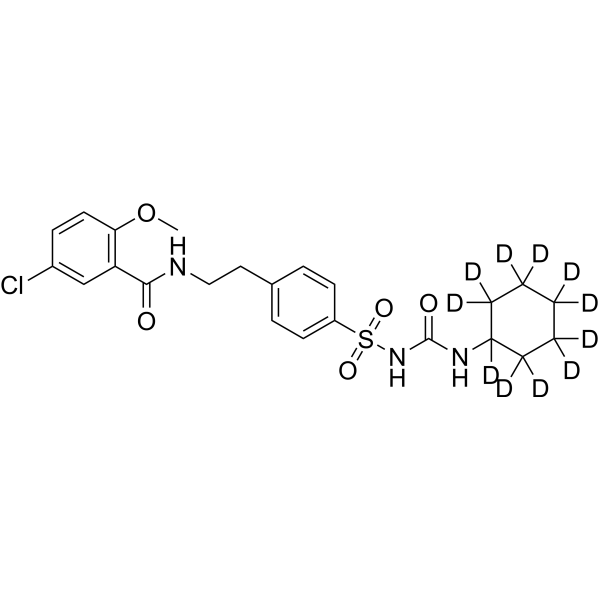
- HY-15206S1
-
|
Glyburide-d3
|
Potassium Channel
Mitochondrial Metabolism
Autophagy
CFTR
P-glycoprotein
|
Metabolic Disease
|
|
Glyburide-d3 is the deuterium labeled Glibenclamide. Glibenclamide (Glyburide) is an orally active ATP-sensitive K+ channel (KATP) inhibitor and can be used for the research of diabetes and obesity[1]. Glibenclamide inhibits P-glycoprotein. Glibenclamide directly binds and blocks the SUR1 subunits of KATP and inhibits the cystic fibrosis transmembrane conductance regulator protein (CFTR)[3]. Glibenclamide interferes with mitochondrial bioenergetics by inducing changes on membrane ion permeability[4]. Glibenclamide can induce autophagy[5].
|
-
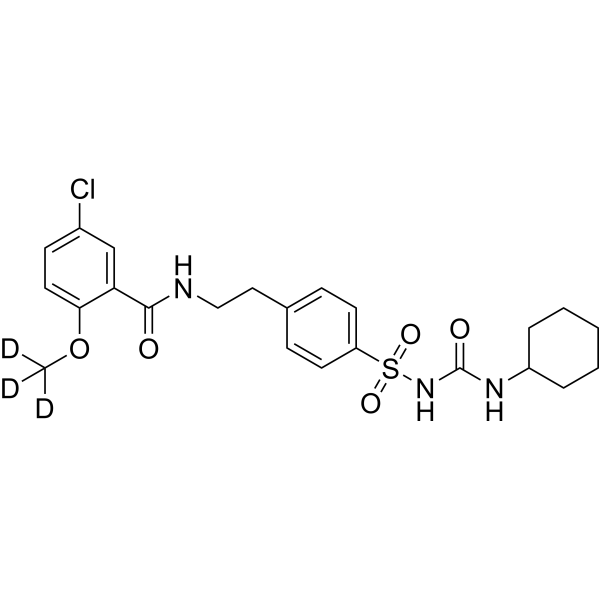
- HY-N10564
-
|
|
P-glycoprotein
|
Cancer
|
|
8α,9α-Epoxycoleon-U-quinone (compound 3) is a p-glycoprotein (P-gp) regulator that is selective for cancer cells (SI=2.0). 8α,9α-Epoxycoleon-U-quinone effectively inhibits P-gp activity in NCI-H460/R cells. 8α,9α-Epoxycoleon-U-quinone also reverses the resistance of cancer cells to Doxorubicin (DOX) (HY-15142A) and enhances the anticancer effect of DOX .
|
-
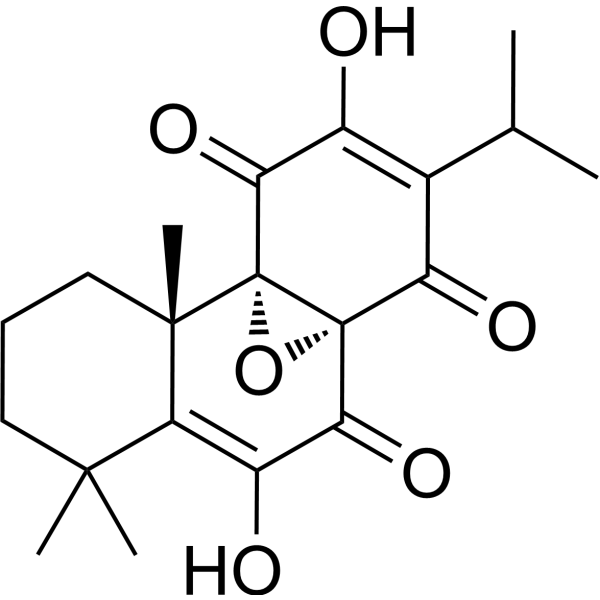
- HY-101791
-
|
|
P-glycoprotein
|
Cancer
|
|
P-gp inhibitor 1 is a novel inhibitor reversing P-glycoprotein-mediated multidrug resistance.
|
-
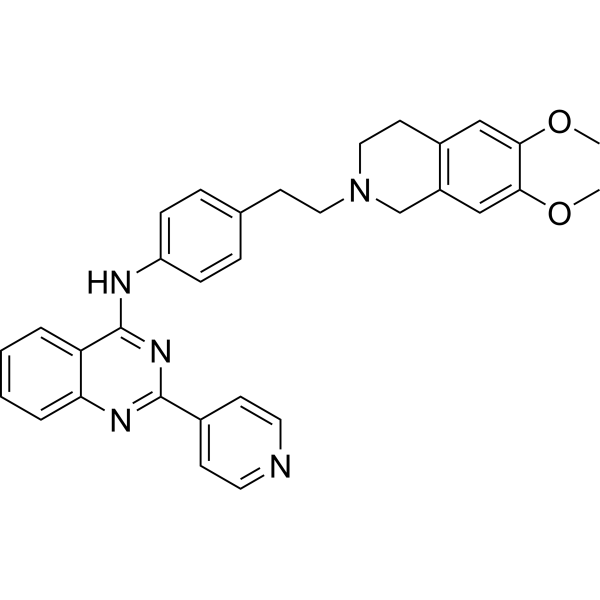
- HY-13776A
-
|
|
P-glycoprotein
|
Cancer
|
|
XR9051 hydrochloride is an orally active and specific modulator of P-glycoprotein-mediated multidrug resistance (MDR) .
|
-
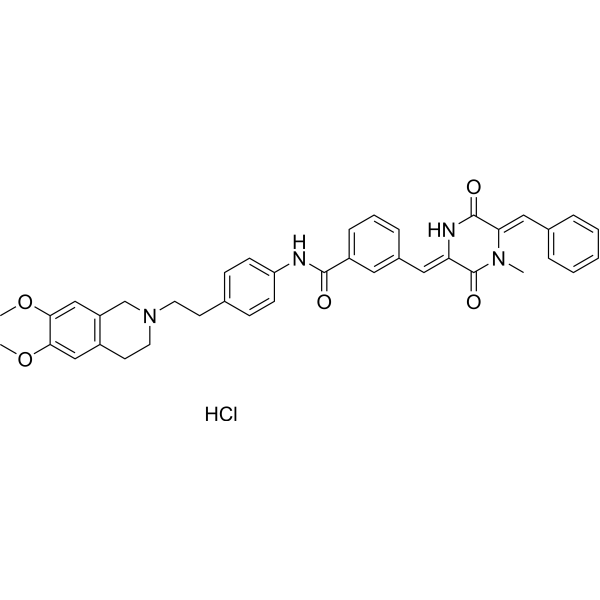
- HY-N10075
-
|
|
P-glycoprotein
|
Others
|
|
Euphohelioscopin A is a diterpenoid can be isolated from the Euphorbia helioscopia L. plant. Euphohelioscopin A weakly inhibits P-glycoprotein-mediated efflux of mitoxantrone .
|
-
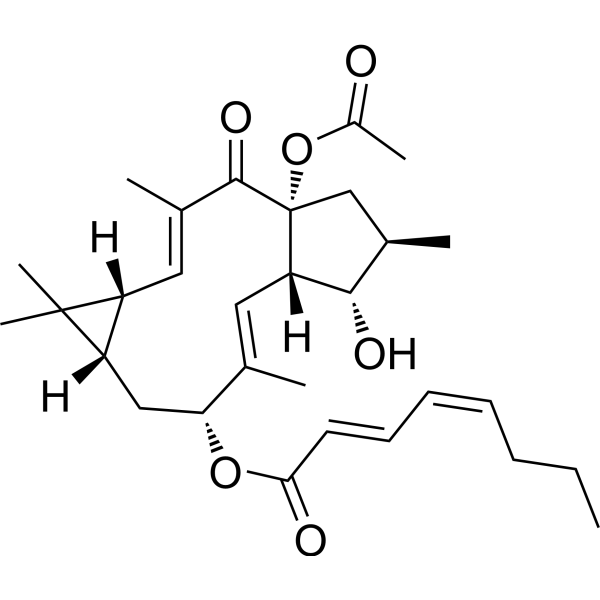
- HY-136589
-
-
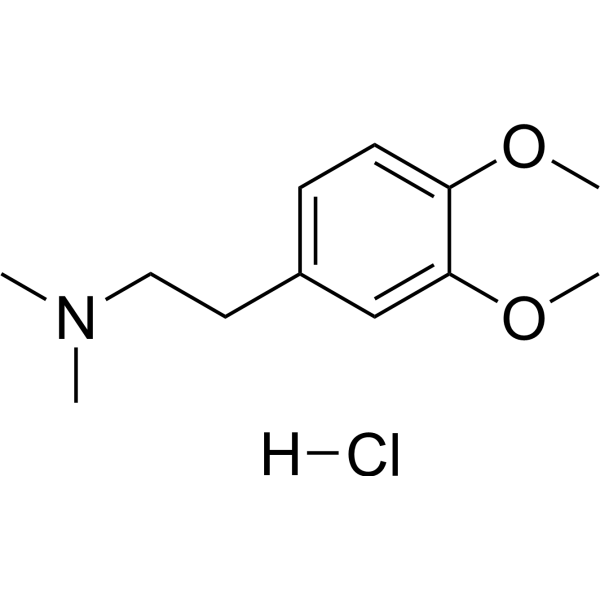
- HY-149240
-
|
|
P-glycoprotein
|
Cancer
|
|
Anticancer agent 108 (Compound 3.10) is a potent P-gp inhibitor with significant antitumor activity and less toxicity to normal and pseudonormal cells. Anticancer agent 108 (Compound 3.10) had no acute toxic effect on С57BL/6 mice .
|
-
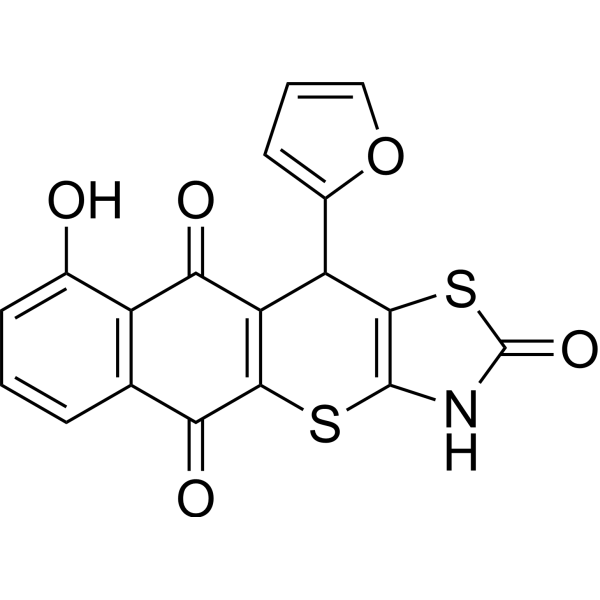
- HY-117452
-
-
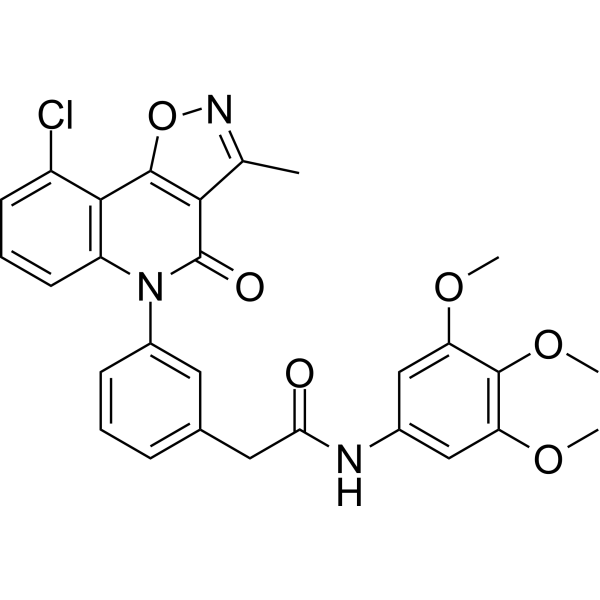
- HY-12757
-
|
|
BCRP
|
Cancer
|
|
YHO-13177 is a potent and specific inhibitor of BCRP; potentiated the cytotoxicity of SN-38 in cancer cells and no effect on P-glycoprotein–mediated paclitaxel resistance in MDR1-transduced human leukemia K562 cells.
|
-
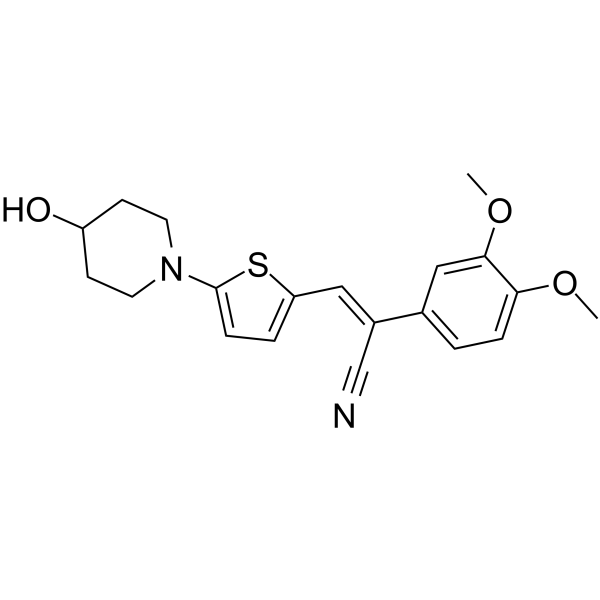
- HY-15584
-
|
HTI-286; SPA-110
|
Microtubule/Tubulin
ADC Cytotoxin
Apoptosis
|
Cancer
|
|
Taltobulin (HTI-286), a synthetic analogue of the tripeptide hemiasterlin, is a potent antimicrotubule agent that circumvents P-glycoprotein-mediated resistance in vitro and in vivo. Taltobulin inhibits the polymerization of purified tubulin, disrupts microtubule organization in cells, and induces mitotic arrest, as well as apoptosis .
|
-
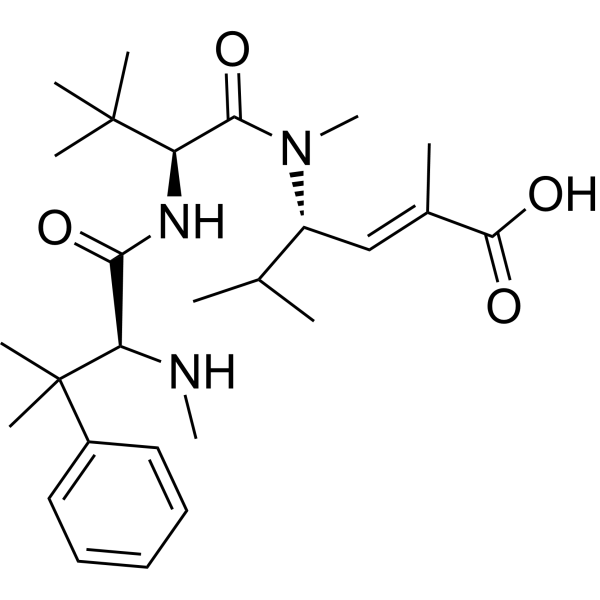
- HY-15584A
-
|
HTI-286 trifluoroacetate; SPA-110 trifluoroacetate
|
Microtubule/Tubulin
ADC Cytotoxin
Apoptosis
|
Cancer
|
|
Taltobulin trifluoroacetate (HTI-286 trifluoroacetate), a synthetic analogue of the tripeptide hemiasterlin, is a potent antimicrotubule agent that circumvents P-glycoprotein-mediated resistance in vitro and in vivo. Taltobulin trifluoroacetate inhibits the polymerization of purified tubulin, disrupts microtubule organization in cells, and induces mitotic arrest, as well as apoptosis .
|
-
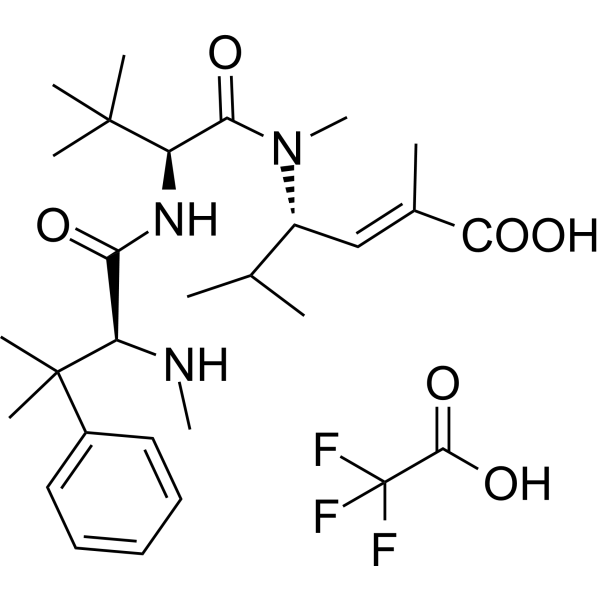
- HY-15584B
-
|
HTI-286 hydrochloride; SPA-110 hydrochloride
|
Microtubule/Tubulin
ADC Cytotoxin
Apoptosis
|
Cancer
|
|
Taltobulin hydrochloride (HTI-286 hydrochloride), a synthetic analogue of the tripeptide hemiasterlin, is a potent antimicrotubule agent that circumvents P-glycoprotein-mediated resistance in vitro and in vivo. Taltobulin hydrochloride inhibits the polymerization of purified tubulin, disrupts microtubule organization in cells, and induces mitotic arrest, as well as apoptosis .
|
-
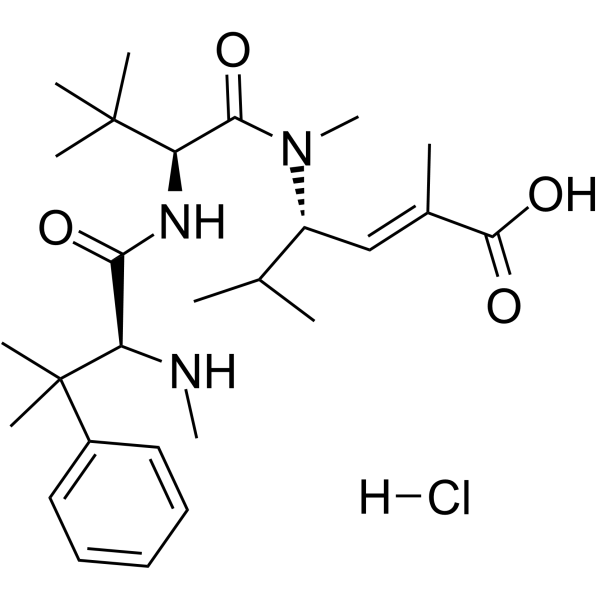
- HY-157483
-
|
|
P-glycoprotein
|
Cancer
|
|
P-gp inhibitor 18 (compound 6G) is a potent inhibitor of P-gp. P-gp inhibitor 18 inhibits rhodamine 123 efflux in the P-gp overexpressed leukemia cells, K562/Dox .
|
-
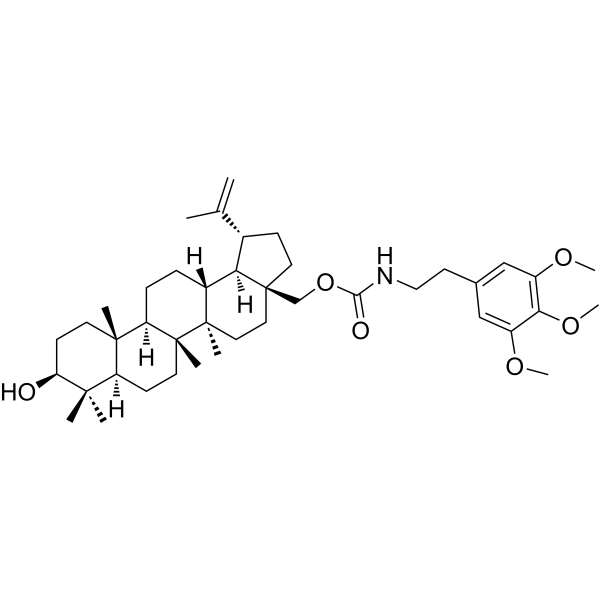
- HY-155368
-
|
|
Cholinesterase (ChE)
|
Neurological Disease
|
|
BChE-IN-20 (compound 7c) is a highly potent BChE-selective inhibitor and exhibits IC50s of 105 and 2.3 nM for eqBChE and hBChE, respectively. BChE-IN-20 inhibits P glycoprotein with IC50 of 0.27 μM. BChE-IN-20 is a promising template to improve design and development of BChE-selective ligands of pharmaceutical interest, including inhibitors and fluorogenic probes.
|
-
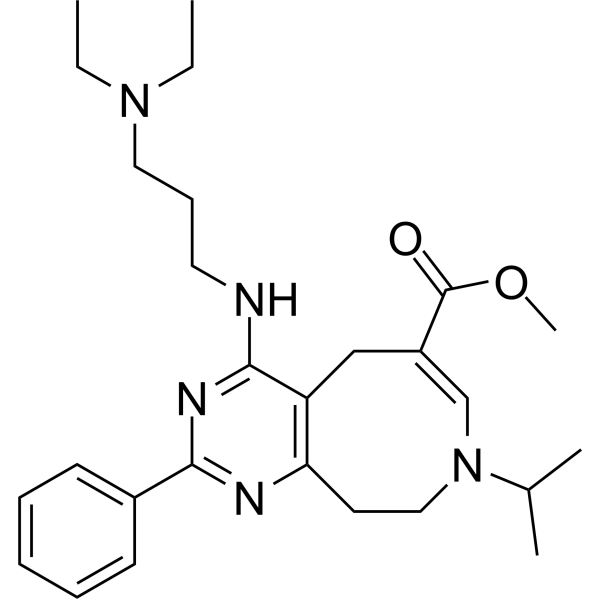
- HY-155391
-
|
|
Carbonic Anhydrase
P-glycoprotein
Wnt
β-catenin
|
Cancer
|
|
hCA/Wnt/β-catenin-IN-1 (Compd 15) is an inhibitor of hCA (Ki: 33.6, 24.1, 6.8 nM for hCA II, hCA IX, hCA XII). hCA/Wnt/β-catenin-IN-1 reduces P-gp activity. hCA/Wnt/β-catenin-IN-1 also inhibits Wnt/β-catenin signaling pathway. hCA/Wnt/β-catenin-IN-1 inhibits cancer cell viability, including the NCI/ADR-RES DOX-resistant cell line .
|
-
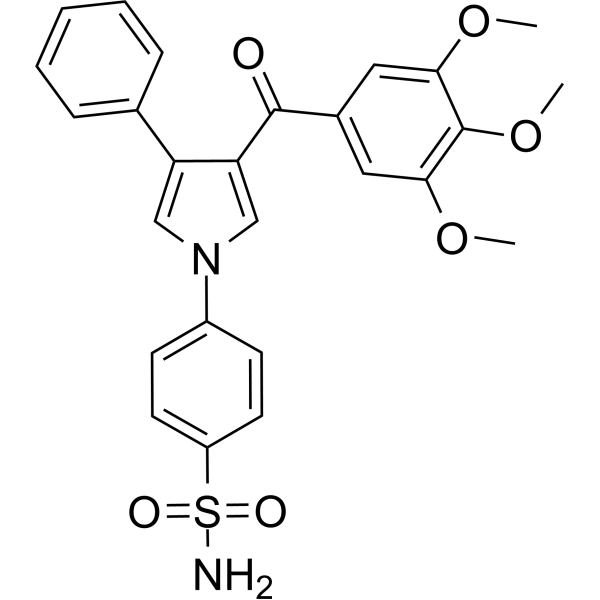
- HY-163204
-
|
|
P-glycoprotein
|
Cancer
|
|
RhQ-DMB is a potent inhibitor of P-gp. RhQ-DMB exhibits high affinity and inhibitory activity in yeast strains expressing CmABCB1 .
|
-
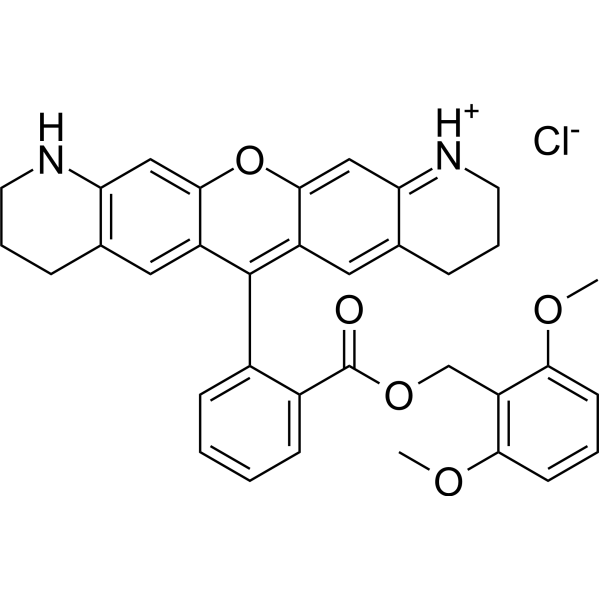
- HY-151517
-
|
|
Ras
|
Cancer
|
|
SOS1-IN-14 is a potent, selective and orally active SOS1 inhibitor with an IC50 value of 3.9 nM. SOS1-IN-14 can be absorbed in the intestine via a P-glycoprotein-mediated efflux mechanism. SOS1-IN-14 can be used to research KRAS-mutated cancers. SOS1-IN-14 has better potent tumor suppression than BI-3406 (HY-125817) .
|
-

- HY-14348
-
|
|
5-HT Receptor
Dopamine Receptor
|
Neurological Disease
|
|
GSK163090 is a potent, selective and orally active 5-HT1A/1B/1D receptor antagonist with pKi values of 9.4/8.5/9.7, respectively. GSK163090 inhibits the functional activity of serotonin reuptake transporter (SerT) with a pKi value of 6.1. GSK163090 has antidepressant and anxiolytic activities .
|
-
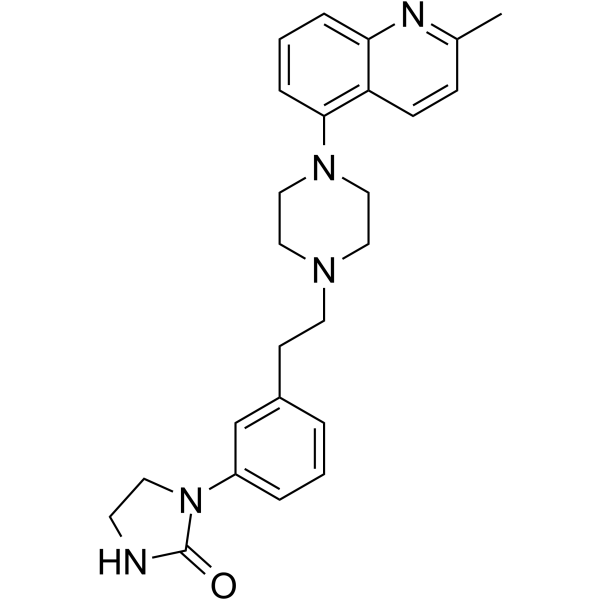
- HY-108511A
-
|
|
Sigma Receptor
Apoptosis
SARS-CoV
|
Infection
Cancer
|
|
PB28 is a cyclohexylpiperazine derivative and a high affinity and selective sigma 2 (σ2) receptor agonist with a Ki of 0.68 nM. PB28 is also a σ1 antagonist with a Ki of 0.38 nM. PB28 is less affinity for other receptors. PB28 inhibits electrically evoked twitch in guinea pig bladder and ileum with EC50 values of 2.62 μM and 3.96 μM, respectively. PB28 can modulate SARS-CoV-2-human protein-protein interaction. PB28 induces caspase-independent apoptosis and has antitumor activity .
|
-

- HY-108511
-
|
|
Sigma Receptor
Apoptosis
SARS-CoV
|
Infection
Cancer
|
|
PB28 dihydrochloride, a cyclohexylpiperazine derivative, is a high affinity and selective sigma 2 (σ2) receptor agonist with a Ki of 0.68 nM. PB28 dihydrochloride is also a σ1 antagonist with a Ki of 0.38 nM. PB28 dihydrochloride is less affinity for other receptors. PB28 dihydrochloride inhibits electrically evoked twitch in guinea pig bladder and ileum with EC50 values of 2.62 μM and 3.96 μM, respectively. PB28 dihydrochloride can modulate SARS-CoV-2-human protein-protein interaction. PB28 dihydrochloride induces caspase-independent apoptosis and has antitumor activity .
|
-
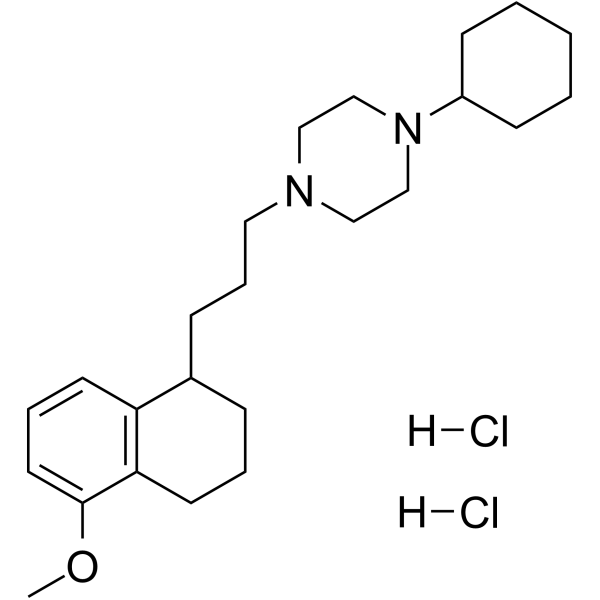
- HY-17411
-
-
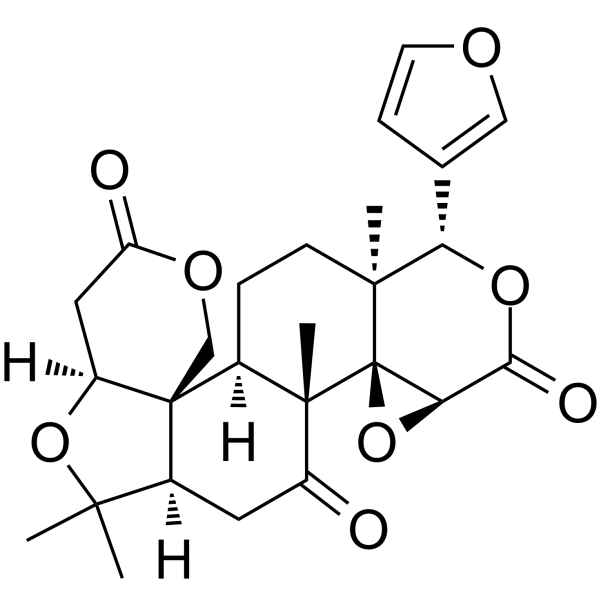
- HY-B0387A
-
|
U70226E free base
|
Potassium Channel
|
Cardiovascular Disease
|
|
Ibutilide (U70226E free base), an action potential-prolonging antiarrhythmic, is a potent blocker of the rapidly activating delayed rectifier K + current (IKr) in AT-1 cells .
|
-
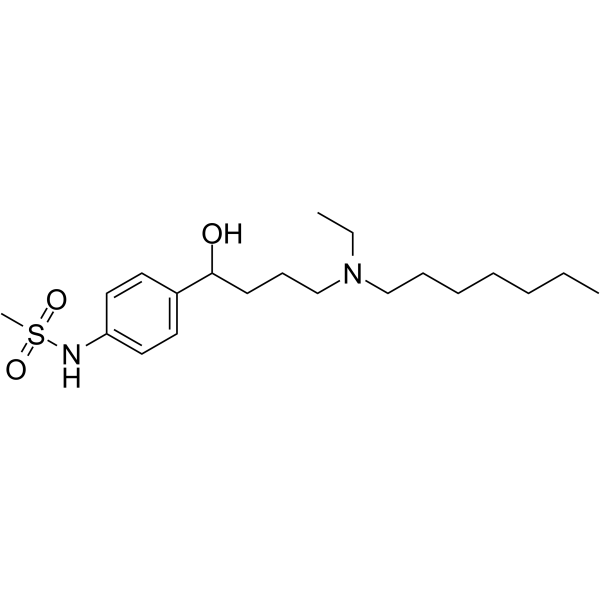
- HY-B0387
-
|
U70226E
|
Potassium Channel
|
Cardiovascular Disease
|
|
Ibutilide (U70226E) fumarate, an action potential-prolonging antiarrhythmic, is a potent blocker of the rapidly activating delayed rectifier K + current (IKr) in AT-1 cells .
|
-
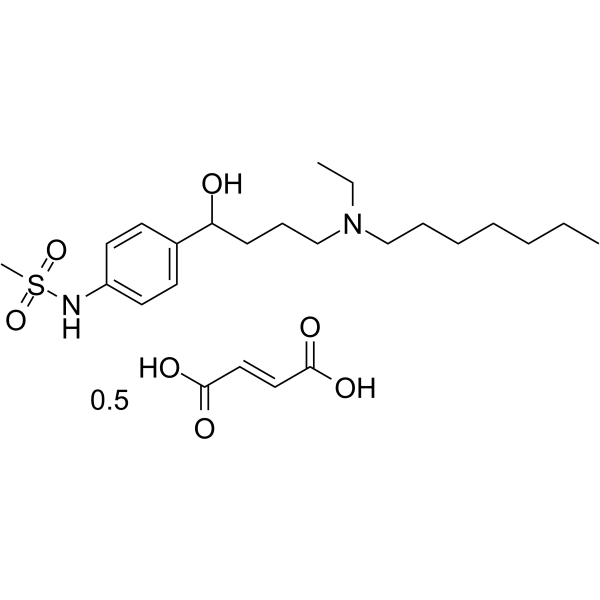
- HY-162101
-
|
|
Topoisomerase
|
Cancer
|
|
Topoisomerase inhibitor 3 (compound 9) is a potent inhibitor of Topoisomerase. Topoisomerase inhibitor 3 has anti-tumor activity .
|
-
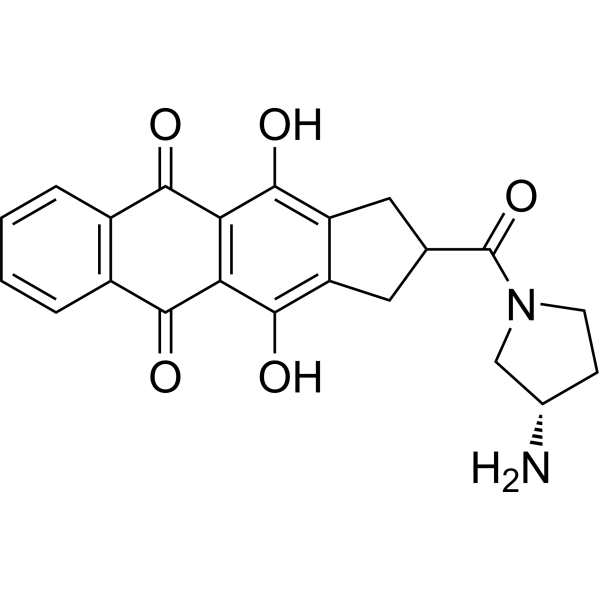
- HY-119873
-
|
REV 5320
|
NO Synthase
Adrenergic Receptor
|
Cardiovascular Disease
|
|
Celiprolol (REV 5320) is a potent, cardioselective and orally active β1-andrenoceptor r antagonist with partial β2 agonist activity, with Ki values of 0.14-8.3 μM. Celiprolol has antihypertensive and antianginal activity, and can be used for the research of cardiovascular disease such as high blood pressure .
|
-
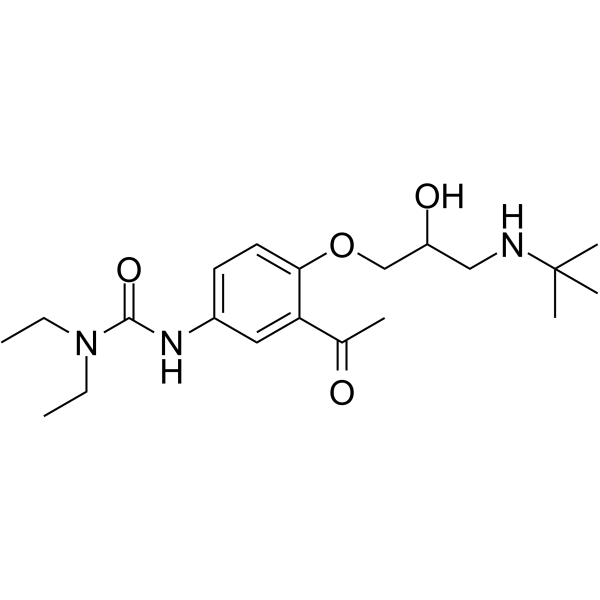
| Cat. No. |
Product Name |
Type |
-
- HY-133948
-
|
Glyceryl palmitoleate
|
Biochemical Assay Reagents
|
|
1-Palmitoleoyl glycerol is a biologically active monoacylglycerol. It increases daunomycin accumulation, shown to inhibit P-glycoprotein in Caco-2 cells. 1-Palmitoleoyl glycerol induces thymocyte apoptosis.
|
| Cat. No. |
Product Name |
Target |
Research Area |
-
- HY-125486
-
|
|
P-glycoprotein
|
Cancer
|
|
Reversin 121 is a P-glycoprotein inhibitor. Reversin 121 increases the ATPase activity of MDR1. Reversin 121 reverses P-glycoprotein-mediated multidrug resistance. Reversin 121 can be used in the research of cancers .
|
-
- HY-136934
-
|
[Boc-Glu(Obzl)]2-Lys-Ome
|
P-glycoprotein
|
Cancer
|
|
Reversin 205 ([Boc-Glu(Obzl)]2-Lys-Ome) is a P-glycoprotein (ABCB1) inhibitor. Reversin 205 is a peptide chemosensitizer .
|
-
- HY-162396
-
|
|
P-glycoprotein
|
Cancer
|
|
P-gp inhibitor 21 (Compound 56) is an inhibitor for P-glycoprotein (P-gp) transport, which reverses P-gp-mediated multidrug resistance (MDR) and exhibits antitumor efficacy in mice without significant cytotoxicity .
|
| Cat. No. |
Product Name |
Category |
Target |
Chemical Structure |
| Cat. No. |
Compare |
Product Name |
Species |
Source |
Compare Products
|
| Products |
|
| Cat. No. |
|
| Species |
|
| Source |
|
| Tag |
|
| Accession |
|
| Gene ID |
|
| Molecular Weight |
|
| Purity |
|
| Endotoxin Level |
|
| Biological Activity |
|
| Appearance |
|
| Formulation |
|
| Storage & Stability |
|
| Shipping |
|
| Free Sample |
Yes
No
|
| Size |
* This product has been "discontinued".
Optimized version of product available:
|
| Cat. No. |
Product Name |
Chemical Structure |
-
- HY-135328AS
-
|
|
|
Norverapamil-d7 (hydrochloride) is a deuterium labeled Norverapamil. Norverapamil ((±)-Norverapamil), an N-demethylated metabolite of Verapamil, is a L-type calcium channel blocker and a P-glycoprotein (P-gp) function inhibitor[1][2].
|
-

-
- HY-110232
-
|
|
|
Risperidone-d4 is the deuterium labeled Risperidone. Risperidone is a serotonin 5-HT2 receptor blocker, P-Glycoprotein inhibitor and potent dopamine D2 receptor antagonist, with Kis of 4.8, 5.9 nM for 5-HT2A and dopamine D2 receptor, respectively.
|
-

-
- HY-A0064S
-
|
|
|
Verapamil-d3 (hydrochloride) is the deuterium labeled Verapamil hydrochloride. Verapamil hydrochloride ((±)-Verapamil hydrochloride) is a calcium channel blocker and a potent and orally active first-generation P-glycoprotein (P-gp) inhibitor. Verapamil hydrochloride also inhibits CYP3A4. Verapamil hydrochloride has the potential for high blood pressure, heart arrhythmias and angina research[1][2][3].
|
-

-
- HY-135328S
-
|
|
|
Norverapamil-d7 is a deuterium labeled Norverapamil ((±)-Norverapamil). Norverapamil, an N-demethylated metabolite of Verapamil, is a L-type calcium channel blocker and a P-glycoprotein (P-gp) function inhibitor[1][2].
|
-

-
- HY-135336S
-
|
|
|
(R)-Verapamil-d7 (hydrochloride) is a deuterium labeled (R)-Verapamil hydrochloride. (R)-Verapamil hydrochloride ((R)-(+)-Verapamil hydrochloride) is a P-Glycoprotein inhibitor. (R)-Verapamil hydrochloride blocks MRP1 mediated transport, resulting in chemosensitization of MRP1-overexpressing cells to anticancer agents[1][2].
|
-

-
- HY-14275S1
-
|
|
|
Verapamil-d7 is the deuterium labeled Verapamil (HY-14275). Verapamil ((±)-Verapamil) is a calcium channel blocker and a potent and orally active first-generation P-glycoprotein (P-gp) inhibitor. Verapamil also inhibits CYP3A4. Verapamil has the potential for high blood pressure, heart arrhythmias and angina research .
|
-

-
- HY-A0064S1
-
|
|
|
Verapamil-d6 (CP-16533-1-d6) hydrochloride is the deuterium labled Verapamil (hydrochloride) (HY-A0064). Verapamil hydrochloride ((±)-Verapamil hydrochloride) is a calcium channel blocker and a potent and orally active first-generation P-glycoprotein (P-gp) inhibitor. Verapamil hydrochloride also inhibits CYP3A4. Verapamil hydrochloride has the potential for high blood pressure, heart arrhythmias and angina research .
|
-

-
- HY-11018S2
-
|
|
|
Risperidone-d6 (R 64 766-d6) is the deuterium labeled Risperidone (HY-11018). Risperidone is a serotonin 5-HT2 receptor blocker, P-Glycoprotein inhibitor and potent dopamine D2 receptor antagonist, with Kis of 4.8, 5.9 nM for 5-HT2A and dopamine D2 receptor, respectively .
|
-

-
- HY-17367S3
-
|
|
|
Atazanavir-d5 is the deuterium labeled Atazanavir. Atazanavir (BMS-232632), a highly selective HIV-1 protease inhibitor, is the first protease inhibitor approved for once-daily administration[1]. Atazanavir (BMS-232632) is a substrate and inhibitor of CYP3A4, and an inhibitor and inducer of P-glycoprotein (P-gp)[2]. Atazanavir is also a SARS-CoV 3CLpro inhibitor with an IC50 of 3.49 μM[3].
|
-

-
- HY-17367S2
-
|
|
|
Atazanavir-d9 is the deuterium labeled Atazanavir. Atazanavir (BMS-232632), a highly selective HIV-1 protease inhibitor, is the first protease inhibitor approved for once-daily administration[1]. Atazanavir (BMS-232632) is a substrate and inhibitor of CYP3A4, and an inhibitor and inducer of P-glycoprotein (P-gp)[2]. Atazanavir is also a SARS-CoV 3CLpro inhibitor with an IC50 of 3.49 μM[3].
|
-

-
- HY-17367S4
-
|
|
|
Atazanavir-d6 is deuterium labeled Atazanavir. Atazanavir (BMS-232632), a highly selective HIV-1 protease inhibitor, is the first protease inhibitor approved for once-daily administration[1]. Atazanavir (BMS-232632) is a substrate and inhibitor of CYP3A4, and an inhibitor and inducer of P-glycoprotein (P-gp)[2]. Atazanavir is also a SARS-CoV 3CLpro inhibitor with an IC50 of 3.49 μM[3].
|
-

-
- HY-15206S
-
|
|
|
Glyburide-d11 is the deuterium labeled Glibenclamide. Glibenclamide (Glyburide) is an orally active ATP-sensitive K+ channel (KATP) inhibitor and can be used for the research of diabetes and obesity[1]. Glibenclamide inhibits P-glycoprotein. Glibenclamide directly binds and blocks the SUR1 subunits of KATP and inhibits the cystic fibrosis transmembrane conductance regulator protein (CFTR)[3]. Glibenclamide interferes with mitochondrial bioenergetics by inducing changes on membrane ion permeability[4]. Glibenclamide can induce autophagy[5].
|
-

-
- HY-15206S1
-
|
|
|
Glyburide-d3 is the deuterium labeled Glibenclamide. Glibenclamide (Glyburide) is an orally active ATP-sensitive K+ channel (KATP) inhibitor and can be used for the research of diabetes and obesity[1]. Glibenclamide inhibits P-glycoprotein. Glibenclamide directly binds and blocks the SUR1 subunits of KATP and inhibits the cystic fibrosis transmembrane conductance regulator protein (CFTR)[3]. Glibenclamide interferes with mitochondrial bioenergetics by inducing changes on membrane ion permeability[4]. Glibenclamide can induce autophagy[5].
|
-

| Cat. No. |
Product Name |
Application |
Reactivity |
-
- HY-P80772
-
|
p-pg; ABCB1; MDR1; PGY1; Multidrug resistance protein 1; ATP-binding cassette sub-family B member 1; P-glycoprotein 1; CD antigen CD243
|
WB
|
Human |
|
P Glycoprotein Antibody is a non-conjugated and Rabbit origined monoclonal antibody about 141 kDa, targeting to P Glycoprotein. It can be used for WB assays with tag free, in the background of Human.
|
-
- HY-P80527
-
|
ABCB5 P-gp; ATP binding cassette sub family B (MDR/TAP) member 5; P glycoprotein ABCB5
|
WB, ICC/IF
|
Human |
|
ABCB5 Antibody (YA836) is a non-conjugated and Mouse origined monoclonal antibody about 139 kDa, targeting to ABCB5 (8D2). It can be used for WB,ICC/IF assays with tag free, in the background of Human.
|
Your information is safe with us. * Required Fields.
Inquiry Information
- Product Name:
- Cat. No.:
- Quantity:
- MCE Japan Authorized Agent:










































































































































